Wuhan
Wuhan (simplified Chinese: 武汉; traditional Chinese: 武漢, [ù.xân] (![]()
Wuhan 武汉市 | |
|---|---|
Sub-provincial city | |
Clockwise from top: Skyline of Wuhan, Tortoise Mountain TV Tower, East Lake, Wuchang Uprising Memorial, Yellow Crane Tower | |
 Seal | |
| Nickname(s): | |
| Motto(s): 武汉, 每天不 – 样 ("Wuhan, Different Everyday!") | |
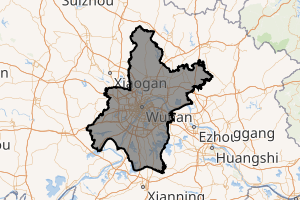
| |
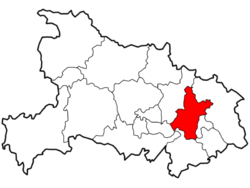 Location of Wuhan City jurisdiction in Hubei | |
 Wuhan Location of the city center in Hubei 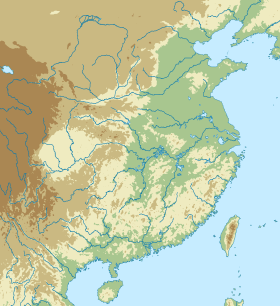 Wuhan Wuhan (Eastern China) 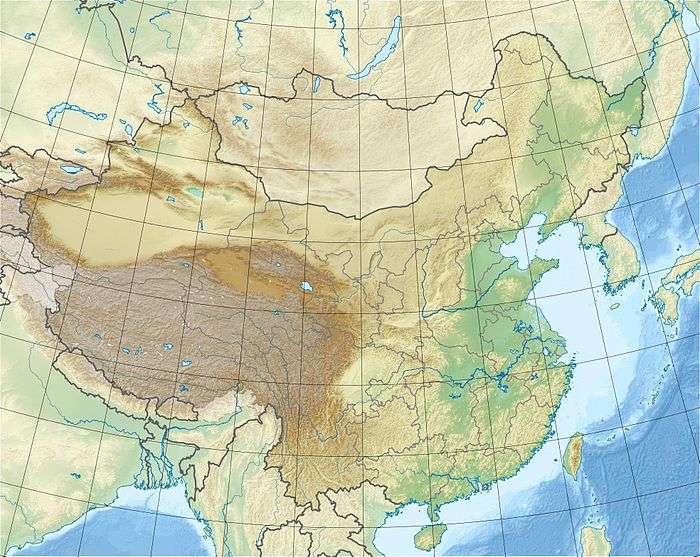 Wuhan Wuhan (China) | |
| Coordinates (Wuhan municipal government): 30°35′36″N 114°18′17″E | |
| Country | People's Republic of China |
| Province | Hubei |
| Settled | 1500 BC |
| First unified | January 1, 1927[6] |
| Hancheng walls built | 223 BC |
| Municipal seat | Jiang'an District |
| Divisions[6][7] County-level Township-level | 13 districts 156 subdistricts, 1 towns, 3 townships |
| Government | |
| • Party Secretary | Wang Zhonglin |
| • Mayor | Zhou Xianwang[8] |
| Area | |
| • Sub-provincial city | 8,494.41 km2 (3,279.71 sq mi) |
| • Urban (2018)[10] | 1,528 km2 (590 sq mi) |
| Population (2018) | |
| • Sub-provincial city | 11,081,000[11] |
| • Urban (2018)[10] | 8,896,900[11] |
| • Metro | 19 million |
| Demonym(s) | Wuhanese |
| Languages | |
| • Languages | Wuhan dialect, Standard Chinese |
| Major ethnic groups | |
| • Major ethnic groups | Han |
| Time zone | UTC+08:00 (China Standard) |
| Postal code | 430000–430400 |
| Area code(s) | 0027 |
| ISO 3166 code | CN-HB-01 |
| GDP[13] | 2018 |
| – Total | CNY 1.485 trillion USD 224.28 billion (8th) |
| - Per capita | CNY 138,759 USD 20,960 (nominal) – 40,594 (purchasing power parity) (11th) |
| - Growth | |
| License plate prefixes | 鄂A 鄂O (police and authorities) |
| HDI (2015) | 0.839[14] (9th) – very high |
| City tree | Metasequoia[15] |
| City flower | Plum blossom[16] |
| Website | 武汉政府门户网站 (Wuhan Government Web Portal) (in Chinese); English Wuhan (in English) |
| Wuhan | |||||||||||||||||||||||||||||||
|---|---|---|---|---|---|---|---|---|---|---|---|---|---|---|---|---|---|---|---|---|---|---|---|---|---|---|---|---|---|---|---|
.svg.png) "Wuhan" in Simplified (top) and Traditional (bottom) Chinese characters | |||||||||||||||||||||||||||||||
| Simplified Chinese | 武汉 | ||||||||||||||||||||||||||||||
| Traditional Chinese | 武漢 | ||||||||||||||||||||||||||||||
| Literal meaning | "[The combined cities of] Wǔ[chāng] and Hàn[kǒu]" | ||||||||||||||||||||||||||||||
| |||||||||||||||||||||||||||||||
The name "Wuhan" came from the city's historical origin from the conglomeration of Wuchang, Hankou and Hanyang, which are collectively known as the "Three Towns of Wuhan" (武汉三镇). It lies in the eastern Jianghan Plain, at the confluence of the Yangtze river and its largest tributary, the Han River and is known as "Nine Provinces' Thoroughfare" (九省通衢).[1]
Wuhan is considered by some to be one of the potential sites of the pivotal Battle of the Red Cliffs, which stopped warlord Cao Cao's incursion into southern China at the end of the Eastern Han dynasty. Other historical events taking place in Wuhan include the Wuchang Uprising of 1911, which led to the downfall of the Qing dynasty and the establishment of the Republic of China.[20] Wuhan was briefly the capital of China in 1927 under the left wing of the Kuomintang (KMT) government led by Wang Jingwei.[21] The city later served as the wartime capital of China for ten months in 1937 during the Second Sino-Japanese War.[22][23] SARS-CoV-2, a novel coronavirus that caused the COVID-19 pandemic, was first identified in Wuhan in December 2019.[24][25]
Wuhan is considered the political, economic, financial, commercial, cultural and educational center of Central China.[18] It is a major transportation hub, with dozens of railways, roads and expressways passing through the city and connecting to other major cities.[26] Because of its key role in domestic transportation, Wuhan is sometimes referred to as "the Chicago of China" by foreign sources.[3][4][5] The "Golden Waterway" of the Yangtze River and the Han River traverse the urban area and divide Wuhan into the three districts of Wuchang, Hankou and Hanyang. The Wuhan Yangtze River Bridge crosses the Yangtze in the city. The Three Gorges Dam, the world's largest power station in terms of installed capacity, is located nearby. Historically, Wuhan has suffered risks of flooding,[27] prompting the government to alleviate the situation by introducing ecologically friendly absorption mechanisms.[28]
While Wuhan has been a traditional manufacturing hub for decades, it is also one of the areas promoting modern industrial changes in China. Wuhan consists of three national development zones, four scientific and technological development parks, over 350 research institutes, 1,656 high tech enterprises, numerous enterprise incubators and investments from 230 Fortune Global 500 firms.[29] It produced GDP of US$22.4 billion in 2018. The Dongfeng Motor Corporation, an automobile manufacturer, is headquartered in Wuhan. The city is home to multiple notable institutes of higher education, including Wuhan University[30] and the Huazhong University of Science and Technology. In 2017, Wuhan was designated as a Creative City by UNESCO, in the field of design.[31] Wuhan is classified as a Beta world city by the Globalization and World Cities Research Network.[32]
Etymology
The name "Wuhan" is a portmanteau of the two major cities on the northern and southern banks of the Yangtze River that make up the Wuhan metropolis: "Wu" refers to the city of Wuchang (Chinese: 武昌), which lies on the southern bank of the Yangtze, while "Han" refers to the city of Hankou (Chinese: 汉口), which lies on the northern bank of the Yangtze.
In 1926, the Northern Expedition reached the Wuhan area and it was decided to merge Hankou, Wuchang and Hanyang into one city in order to make a new capital for Nationalist China. On January 1, 1927,[33] the resulting city was proclaimed as '武漢' (the traditional Chinese characters for 'Wuhan'), which was later simplified as '武汉' (also 'Wuhan').[34][35][36]
History
Antiquity
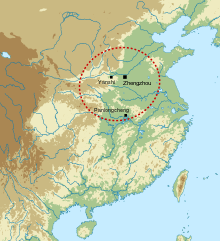
The Wuhan area has been settled for 3,500 years. Panlongcheng, an archaeological site primarily associated with the Erligang culture (c. 1510 – c. 1460 BC) (being sparsely populated during the earlier Erlitou period), is located in modern-day Huangpi District of Wuhan.
During the Western Zhou the State of E, which gives its name to the single character abbreviation for Hubei province, controlled the present-day Wuchang area south of the Yangtze River. After the conquest of the E state in 863 BC, the present-day Wuhan area was controlled by the State of Chu for the rest of the Western Zhou and Eastern Zhou periods. After the State of Huang was conquered by State of Chu in the summer of 648 BC,[37] the people of Huang were moved into the area in and around present-day Wuhan. Local geographical terms including the name of Wuhan's Huangpi District were named after the State of Huang. Chu was in turn conquered by Qin in 223 BC.
Imperial China
During the Han dynasty, Hanyang became a fairly busy port. The Battle of Xiakou in AD 203 and Battle of Jiangxia five years later were fought in the region over control of Jiangxia Commandery, territories of which included much of present-day eastern Hubei. In the winter of 208/9, one of the most famous battles in Chinese history and a central event in the Romance of the Three Kingdoms—the Battle of Red Cliffs—took place near the Yangtze River, with the cliffs near Wuhan identified as one of the potential locations.[38] Around that time, walls were built to protect Hanyang (AD 206) and Wuchang (AD 223). The latter event marks the foundation of Wuhan. In AD 223, the Yellow Crane Tower, one of the Four Great Towers of China, was constructed on the Wuchang side of the Yangtze River by order of Sun Quan, leader of the Eastern Wu. The tower become a sacred site of Taoism.[39]
Due to tensions between the Eastern Wu and Cao Wei kingdoms, in the autumn of 228,[lower-alpha 1] Cao Rui, grandson of Cao Cao and the second emperor of the state of Cao Wei, ordered the general Man Chong to lead troops to Xiakou (夏口; in present-day Wuhan).[41][42] In 279, Wang Jun and his army conquered strategic locations in Wu territory such as Xiling (in present-day Yichang, Hubei), Xiakou (夏口; present-day Hankou) and Wuchang (武昌; present-day Ezhou, Hubei).
During the Northern and Southern dynasties period, the Wuhan area was part of the successive Southern dynasty states Liu Song (420–479), Southern Qi (479–502), Liang, and Western Liang.
In fall 550, Hou Jing sent Ren Yue to attack both Xiao Daxin and Xiao Fan's son Xiao Si (蕭嗣). Ren killed Xiao Si in battle, and Xiao Daxin, unable to resist, surrendered, allowing Hou to take his domain under control. Meanwhile, Xiao Guan, who had by now settled at Jiangxia (江夏, in modern Wuhan), was planning to attack Hou, but this drew Xiao Yi's ire—believing that Xiao Guan was intending to contend for the throne—and he sent Wang to attack Xiao Guan. In summer 567, Chen Xu commissioned Wu Mingche as the governor of Xiang Province and had him command a major part of the troops against Hua, along with Chunyu Liang (淳于量). The opposing sides met at Zhuankou (沌口, in modern Wuhan).
The city has long been renowned as a center for the arts (especially poetry) and for intellectual studies. Cui Hao, a celebrated poet of the Tang dynasty, visited the Yellow Crane Tower in the early 8th century; his poem made it the most celebrated building in southern China.[43]
In spring 877, Wang Xianzhi captured E Prefecture (鄂州, in modern Wuhan). He then returned north, joining forces with Huang again, and they surrounded Song Wei at Song Prefecture (宋州, in modern Shangqiu, Henan). In winter 877, Huang Chao pillaged Qi and Huang (黃州, in modern Wuhan) Prefectures.
Before Kublai Khan arrived in 1259, word reached him that Möngke had died. Kublai decided to keep the death of his brother secret and continued the attack on the Wuhan area, near the Yangtze. The present-day Wuying Pagoda was constructed at the end of the Song Dynasty between attacks by the Mongolian forces. Under the Mongol rulers (Yuan dynasty) (after 1301), the Wuchang prefecture, headquartered in the town, became the capital of Hubei province. Hankou, from the Ming to late Qing, was under the administration of the local government in Hanyang, although it was already one of the four major national markets (zh:四大名镇) of the Ming dynasty.
Hanyang's Guiyuan Temple was completed in the 15th year of Shunzhi (1658).[44]
By the dawn of the 18th century, Hankou had become one of China's top four trading centers. In the late 19th century, railroads were extended on a north–south axis through the city, making Wuhan an important transshipment point between rail and river traffic. Also during this period foreign powers extracted mercantile concessions, with the riverfront of Hankou being divided up into foreign-controlled merchant districts. These districts contained trading firm offices, warehouses, and docking facilities. The French had a concession in Hankou.[45] During the Taiping Rebellion, the Wuhan area was controlled for many years by rebel forces and the Yellow Crane Tower, Xingfu Temple, Zhuodaoquan Temple and other buildings were repurposed or damaged. During the Second Opium War (known in the West as the Arrow War, 1856–1860), the government of the Qing dynasty was defeated by the western powers and signed the Treaties of Tianjin and the Convention of Peking, which stipulated eleven cities or regions (including Hankou) as trading ports. In December 1858, James Bruce, 8th Earl of Elgin, High Commissioner to China, led four warships up the Yangtze River in Wuhan to collect the information needed for opening the trading port in Wuhan.
In the spring of 1861, Counselor Harry Smith Parkes and Admiral Herbert were sent to Wuhan to open a trading port. On the basis of the Convention of Peking, Parkes concluded the Hankou Lend-Lease Treaty with Guan Wen, the governor-general of Hunan and Hubei. It brought an area of 30.53 square kilometers (11.79 sq mi) along the Yangtze River (from latter-day Jianghan Road to Hezuo Road) to become a British Concession and permitted Britain to set up its consulate in the concession.
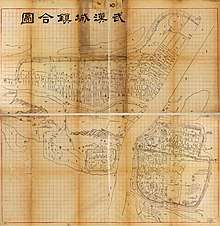
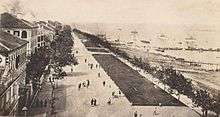
In 1889, Zhang Zhidong was transferred from Viceroy of Liangguang (Guangdong and Guangxi provinces) to Viceroy of Huguang (Hunan and Hubei provinces). He governed the province for 18 years, until 1907. During this period, he elucidated the theory of "Chinese learning as the basis, Western learning for application," known as the ti-yong ideal. He set up many heavy industries, founded Hanyang Steel Plant, Daye Iron Mine, Pingxiang Coal Mine and Hubei Arsenal and set up local textile industries, boosting the flourishing modern industry in Wuhan. Meanwhile, he initiated education reform, opened dozens of modern educational organizations successively, such as Lianghu (Hunan and Hubei) Academy of Classical Learning, Civil General Institute, Military General Institute, Foreign Languages Institute and Lianghu (Hunan and Hubei) General Normal School, and selected a great many students for study overseas, which well promoted the development of China's modern education. Furthermore, he trained a modern military and organized a modern army including a zhen and a xie (both zhen and xie are military units in the Qing dynasty) in Hubei.
Originally known as the Hubei Arsenal, the Hanyang Arsenal was founded in 1891 by Qing official Zhang Zhidong, who diverted funds from the Nanyang Fleet in Guangdong to build the arsenal. It cost about 250,000 pounds sterling and was built in 4 years.[46] On 23 April 1894, construction was completed and the arsenal, occupying some 40 acres (160,000 m2), could start production of small-caliber cannons. It built magazine-fed rifles, Gruson quick fire guns, and cartridges.[47]
Wuchang Uprising

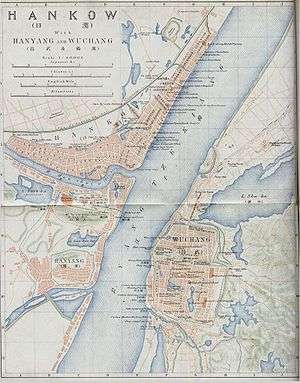
By 1900, according to Collier's magazine, Hankau, the Yangtze River boom town, was "the St. Louis and Chicago of China."[4] On October 10, 1911, Sun Yat-sen's followers launched the Wuchang Uprising,[48] which led to the collapse of the Qing dynasty,[49] as well as the establishment of the Chinese Republic.[50]
The Wuchang Uprising of October 1911, which overthrew the Qing dynasty, originated in Wuhan.[48] Before the uprising, anti-Qing secret societies were active in Wuhan. In September 1911, the outbreak of the protests in Sichuan forced the Qing authorities to send part of the New Army garrisoned in Wuhan to suppress the rebellion.[51] On September 14 the Literary Society (文學社) and the Progressive Association (共進會), two local revolutionary organizations in Hubei,[51] set up joint headquarters in Wuchang and planned for an uprising. On the morning of October 9, a bomb at the office of the political arrangement exploded prematurely and alerted local authorities.[52] The proclamation for the uprising, beadroll and the revolutionaries’ official seal fell into the hands of Rui Cheng, the governor-general of Hunan and Hubei, who demolished the uprising headquarters the same day and set out to arrest the revolutionaries listed in the beadroll.[52] This forced the revolutionaries to launch the uprising earlier than planned.[48]
On the night of October 10, the revolutionaries fired shots to signal the uprising at the engineering barracks of Hubei New Army.[48] They then led the New Army of all barracks to join the revolution.[53] Under the guidance of Wu Zhaolin, Cai Jimin and others, this revolutionary army seized the official residence of the governor and government offices.[51] Rui Cheng fled in panic into the Chuyu ship. Zhang Biao, the commander of the Qing army, also fled the city. On the morning of the 11th, the revolutionary army took the whole city of Wuchang, but leaders such as Jiang Yiwu and Sun Wu disappeared.[48] Thus the leaderless revolutionary army recommended Li Yuanhong, the assistant governor of the Qing army, as the commander-in-chief.[54] Li founded the Hubei Military Government, proclaimed the abolition of the Qing rule in Hubei, the founding of the Republic of China and published an open telegram calling for other provinces to join the revolution.[48][51]
As the revolution spread to other parts of the country, the Qing government concentrated loyalist military forces to suppress the uprising in Wuhan. From October 17 to December 1, the revolutionary army and local volunteers defended the city in the Battle of Yangxia against better armed and more numerous Qing forces commanded by Yuan Shikai. Huang Xing would arrive in Wuhan in early November to take command of the revolutionary army.[51] After fierce fighting and heavy casualties, Qing forces seized Hankou and Hanyang. But Yuan agreed to halt the advance on Wuchang and participated in peace talks, which would eventually lead to the return of Sun Yat-sen from exile, founding of the Republic of China on January 1, 1912.[50][55] Through the Wuchang Uprising, Wuhan is known as the birthplace of the Xinhai Revolution, named after the Xinhai year on the Chinese calendar.[56] The city has several museums and memorials to the revolution and the thousands of martyrs who died defending the revolution.
Republic of China

With the northern extension of the Northern Expedition, the center of the Great Revolution shifted from the Pearl River basin to the Yangtze River basin. On November 26, the Kuomintang Central Political Committee decided to move the capital from Guangzhou to Wuhan. In mid-December, most of the KMT central executive commissioners and national government commissioners arrived in Wuhan, set up the temporary joint conference of central executive commissioners and National Government commissioners, performed the top functions of central party headquarters and National Government, declared they would work in Wuhan on January 1, 1927, and decided to combine the towns of Wuchang, Hankou, and Hanyang into Wuhan City, called "Capital District". The new national government, later known as "Wuhan nationalist government", was based in the Nanyang Building in Hankou, while the central party headquarters and other organizations chose their locations in Hankou or Wuchang.[21]
In March 1927, Mao Zedong appeared at the Third Plenum of the KMT Central Executive Committee in Wuhan, which sought to strip General Chiang of his power by appointing Wang Jingwei leader. The first phase of the Northern Expedition was interrupted by the political split in the Kuomintang following the formation of the Nanjing faction in April 1927 against the existing faction in Wuhan.[57] Members of the Chinese Communist Party, who had survived the April 12 massacre, met at Wuhan and reelected Chen Duxiu (Ch'en Tu-hsiu) as the Party's Secretary General.[58] The split was partially motivated by the purge of the Communists within the party, which marked the end of the First United Front, and Chiang Kai-shek briefly stepped down as the commander of the National Revolutionary Army.[59]
In June 1927, Stalin sent a telegram to the Communists in Wuhan, calling for the mobilization of an army of workers and peasants.[60] This alarmed Wang Jingwei, who decided to break with the Communists and come to terms with Chiang Kai-shek. The Wuhan coup was a political shift made on July 15, 1927, by Wang Jingwei towards Chiang Kai-shek, and his Shanghai-based rival in the Kuomintang. The Wuhan Nationalist Government was established in Wuhan on February 21, 1927, and ended by August 19, 1927.[61] After the end of the Northern Expedition, Hankou was elevated to a centrally-controlled municipality.
In the 1931 China floods, one of the deadliest flood disasters in world history, Wuhan was a refuge for flood victims from outlying areas, who had been arriving since the late spring. But when the city itself was inundated in the early summer, and after a catastrophic dike failure just before 6:00 AM on July 27,[62]:270 an estimated 782,189 urban citizens and rural refugees were left homeless. The flood covered an area of 32 square miles and the city was flooded under many feet of water for close to three months.[62]:269–270 Large numbers gathered on flood islands throughout the city, with 30,000 sheltering on a railway embankment in central Hankou. With little food and a complete breakdown in sanitation, thousands soon began to succumb to diseases.[63] Jin Shilong, Senior Engineer at the Hubei Flood Prevention Agency, described the flooding:
There was no warning, only a sudden great wall of water. Most of Wuhan's buildings in those days were only one story high, and for many people there was no escape – they died by the tens of thousands. ... I was just coming off duty at the company's main office, a fairly new three-story building near the center of town ... When I heard the terrible noise and saw the wall of water coming, I raced to the top story of the building. ... I was in one of the tallest and strongest buildings left standing. At that time no one knew whether the water would subside or rise even higher.[62]:270
The high-water mark was reached on 19 August at Hankou, with the water level exceeding 16 m (53 ft) above normal.[64][65] In 1936, when natural disaster struck Central China with widespread flooding affecting Hebei, Hunan, Jiangxi, Wuhan and Chongqing caused by the Yangtze and Huai Rivers bursting their banks, Ong Seok Kim, as Chairman of the Sitiawan Fundraising and Disaster Relief Committee, raised money and materials in support of the victims.[66][67][68][69]
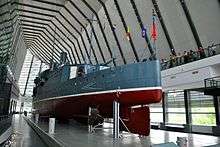
During the Second Sino-Japanese War and following the fall of Nanking in December 1937, Wuhan had become the provisional capital of China's Kuomintang government, and became another focal point of pitched air battles beginning in early 1938 between modern monoplane bomber and fighter aircraft of the Imperial Japanese forces and the Chinese Air Force, which included support from the Soviet Volunteer Group in both planes and personnel, as U.S. support in war materials waned.[70] As the battle raged on through 1938, Wuhan and the surrounding region had become the site of the Battle of Wuhan. After being taken by the Japanese in late 1938, Wuhan became a major Japanese logistics center for operations in southern China.
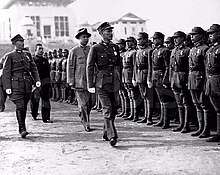
In early October 1938, Japanese troops moved east and north in the outskirts of Wuhan. As a result, numerous companies and enterprises and large numbers of people had to withdraw from Wuhan to the west of Hubei and Sichuan. The KMT navy undertook the responsibility of defending the Yangtze River on patrol and covering the withdrawal. On October 24, while overseeing the waters of the Yangtze River near the town of Jinkou (Jiangxia District in Wuhan) in Wuchang, the KMT gunboat Zhongshan came up against six Japanese aircraft. Though two were eventually shot down, the Zhongshan sank with 25 casualties. Raised from the bottom of the Yangtze River in 1997, and restored at a local shipyard, the Zhongshan has been moved to a purpose-built museum in Wuhan's suburban Jiangxia District, which opened on September 26, 2011.[71]
As a key center on the Yangtze, Wuhan was an important base for Japanese operations in China.[72] On 18 December 1944, Wuhan was bombed by 77 American bombers that set off a firestorm that destroyed much of the city.[73] For the next three days, Wuhan was bombed by the Americans, destroying all of the docks and warehouses of Wuhan, as well as the Japanese air bases in the city. The air raids killed thousands of Chinese civilians which American bombers did not know.[73] "According to casualty statistics compiled by Hankou city in 1946, more than 20,000 were killed or injured in the December bombings of 1944."[74]
Wuhan returned to Chinese control in September 1945. Administratively, Wuchang and Hanyang were initially combined into a new City of Wuchang, but in October 1946 were separated into the City of Wuchang (including Wuchang only) and the County of Hanyang. Hankou became a centrally controlled municipality in August 1947. Militarily, the Wuhan Forward Headquarters was established in Wuhan, headed by Bai Chongxi.[75]
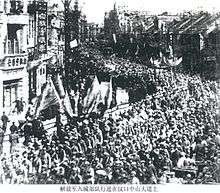
During the later stages of the Chinese Civil War, Bai sought to broker peace, proposing that the Communist Party could rule northern China while the Nationalist government retained southern China. This was rejected, and on 15 May 1949 Bai and the Wuhan garrison retreated from the city. People's Liberation Army troops entered Wuhan on the afternoon of Monday, May 16, 1949.[76][77][78]
People's Republic of China

The Changjiang Water Resources Commission was reestablished in February 1950 with its headquarters in Wuhan. From June to September 1954, the Yangtze River Floods were a series of catastrophic floodings that occurred mostly in Hubei Province. Due to an unusually high volume of precipitation as well as an extraordinarily long rainy season in the middle stretch of the Yangtze River late in the spring of 1954, the river started to rise above its usual level in around late June. In 1969, a large stone monument was erected in the riverside park in Hankou honoring the heroic deeds in fighting the 1954 Yangtze River floods.
Before construction of the Wuhan Yangtze River Bridge, Hunslet Engine Company built two extra heavy 0-8-0 locomotives for loading the train ferries for crossing the Yangtze River in Wuhan.
The project of building the Wuhan Yangtze River Bridge, also known as the First Yangtze River Bridge, was regarded as one of the key projects during the first five-year plan. On October 25, 1955, construction began on the bridge proper. The same day in 1957, the whole project was completed and an opening-to-traffic ceremony was held on October 15. The First Yangtze River Bridge united the Beijing–Hankou Railway with the Guangdong–Hankou Railway into the Beijing–Guangzhou Railway, making Wuhan a 'thoroughfare to nine provinces' (九省通衢) in name and in fact.
After Chengdu Conference, Mao went to Chongqing and Wuhan in April to inspect the countryside and factories. In Wuhan, he called all the leaders of provinces and municipalities who had not attended Chengdu Conference to report their work. Tian Jiaying, the secretary of Mao, said that Wuhan Conference was a supplement to Chengdu Conference.[80]
In July 1967, civil strife struck the city in the Wuhan Incident ("July 20th Incident"), an armed conflict between two hostile groups who were fighting for control over the city at the height of the Cultural Revolution.[81]
In 1981, the Wuhan City Government commenced reconstruction of the Yellow Crane Tower at a new location, about 1 km (0.62 mi) from the original site, and it was completed in 1985. In 1957, the Wuhan Yangtze River Bridge was built with one trestle of the bridge on the site of the tower, which had been last destroyed in 1884.[82]
During the 1989 Tiananmen Square protests, students in Wuhan blocked the Yangtze River Railway bridge and another 4,000 gathered at the railway station.[83]:400 About one thousand students staged a railroad 'sit-in'. Rail traffic on the Beijing-Guangzhou and Wuhan-Dalian lines was interrupted. The students also urged employees of major state-owned enterprises to go on strike.[83]:405 The situation was so tense that residents reportedly began a bank run and resorted to panic-buying.[83]:408
In the wake of the United States bombing of the Chinese embassy in Belgrade on May 7, 1999, protests broke out throughout China, including in Wuhan.[84]
On June 22, 2000, a Wuhan Airlines flight from Enshi to Wuhan was forced to circle for 30 minutes due to thunderstorms. The aircraft eventually crashed on the banks of Han River in Hanyang District,[85] all on-board perished (there were varying accounts of number of crews and passengers). In addition, the crash also killed 7 people on the ground.[86][87][88]
Chinese protesters organized boycotts of the French-owned retail chain Carrefour in major Chinese cities including Kunming, Hefei and Wuhan, accusing the French nation of pro-secessionist conspiracy and anti-Chinese racism.[89] The BBC reported that hundreds of people demonstrated in Beijing, Wuhan, Hefei, Kunming and Qingdao.[90][91] On May 19, 2011, Fang Binxing, the Principal of Beijing University of Posts and Telecommunications (also known as "Father of China's Great Fire Wall"[92][93]) was hit on the chest by a shoe thrown at him by a Huazhong University of Science and Technology student who calls herself "hanjunyi" (寒君依, or 小湖北) while Fang was giving a lecture at Wuhan University.[94][95][96][97][98][99]
The city has been subject to devastating floods, which are now supposed to be controlled by the ambitious Three Gorges Dam, a project which was completed in 2008.[100][101] The 2008 Chinese winter storms damaged water supply equipment in Wuhan: up to 100,000 people were out of running water when several water pipes burst, cutting the supply to local households.[102] The 2010 Northern Hemisphere summer heat wave hit Wuhan on July 3.[103] In the 2010 China floods, the Han River at Wuhan experienced its worst flooding in twenty years, as officials continued sandbagging efforts along the Han and Yangtze Rivers in the city and checked reservoirs.[104] In the 2011 China floods, Wuhan was flooded, with parts of the city losing power.[105] In the 2016 China floods, Wuhan saw 570 mm (22 in) of rainfall during the first week of July, surpassing the record that fell on the city in 1991. A red alert for heavy rainfall was issued on 2 July, the same day that eight people died after a 15-meter (49 ft) section of a 2 m (6.6 ft) tall wall collapsed on top of them.[106] The city's subway system, the Wuhan Metro was partially submerged as was the main railway station.[107] At least 14 city residents were killed, one was missing, and more than 80,000 were relocated.[108]
In early July 2019, there were protests against plans for a new incinerator in Xinzhou District.[109]
The 2019 Military World Games were hosted in Wuhan in October.[110][111]
In December 2019, an epidemic of a new coronavirus disease began in Wuhan.[112] The disease, which became known as coronavirus disease 2019 (COVID-19), spread and developed into the worldwide COVID-19 pandemic. Wuhan and other Hubei cities were placed under lockdown for nearly three months to contain the disease.[113][114] On April 8, 2020, the Wuhan lockdown officially came to an end after no new domestic cases were reported in Hubei province.[115]
Geography
Cityscape
Overview
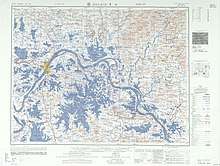
Wuhan is in east-central Hubei, at latitude 29° 58'–31° 22' N and longitude 113° 41'–115° 05' E. Wuhan sits at the confluence of the Han River flowing into the Yangtze River at the East of the Jianghan Plain along the Yangtze's middle reaches.
The metropolitan area comprises three parts—Wuchang, Hankou, and Hanyang—commonly called the "Three Towns of Wuhan" (hence the name "Wuhan", combining "Wu" from the first city and "Han" from the other two). The consolidation of these cities occurred in 1927 and Wuhan was thereby established. The three former cities face each other across the rivers and are linked by bridges, including one of the first modern bridges in China, known as the "First Bridge".
- Wuchang lies South East of the Yangtze River that separates it from both Hankou and Hanyang.
- Hankou sits North of the Yangtze River separating it from Wuchang. Hankou is North of the Han River separating it from Hanyang.
- Hanyang lies West of the Yangtze separating it from Wuchang. Hanyang is south of the Han river separating it from Hankou.
.jpg)
It is simple in terrain—low and flat in the middle and hilly in the south, with the Yangtze and Han rivers winding through the city. The She River enters the Yangtze in Huangpi District. Wuhan occupies a land area of 8,494.41 square kilometers (3,279.71 sq mi), most of which is alluvial plain and decorated with hills and a great number of lakes and ponds. Water makes up one quarter of Wuhan's urban territory, which is the highest percentage among major cities in China.[116] Wuhan has nearly 200 lakes, including the East Lake of 33 km2, and Tangxun Lake, which are the largest lakes entirely within a city in China.[116]
Other well-known lakes include South Lake and Sand Lake. Liangzi Lake, the largest lake by surface area in Hubei province, is located in the southeast of Jiangxia District. At 709 m (2,326 ft) above sea level, the highest point in Wuhan is the main peak of Yunwu Mountain (云雾山) in northwestern Huangpi District.[117] There are also several mountains within the city limits of Wuhan including Mount Luojia (珞珈山) in Wuchang District as well as Mount Hong (洪山) and Mount Yujia (喻家山/瑜珈山) in Hongshan District.[118]
Climate
Wuhan's climate is humid subtropical (Köppen Cfa) with abundant rainfall in summer and four distinctive seasons. Wuhan is known for its humid summers, when dewpoints can often reach 26 °C (79 °F) or more.[119] Historically, along with Chongqing and Nanjing, Wuhan is referred to as one of the "Three Furnacelike Cities" along the Yangtze River for their hot summers.[120] However, the climate data of recent years suggests that Wuhan is no longer among the top tier of "The hottest cities in summer" list, the New Four Furnacelike Cities are Chongqing, Fuzhou, Hangzhou, and Nanchang.[121][122] Spring and autumn are generally mild, while winter is cool with quite low rainfall and occasional snow. The monthly 24-hour average temperature ranges from 4.0 °C (39.2 °F) in January to 29.1 °C (84.4 °F) in July.[123] Annual precipitation totals just under 1,320 mm (52 in),[123] the majority of which falls from April to July; the annual mean temperature is 17.13 °C (62.8 °F),[123] the frost-free period lasts 211 to 272 days.[124] With monthly possible sunshine percentage ranging from 31 percent in March to 59 percent in August, the city proper receives 1,865 hours of bright sunshine annually.[125] Extreme low and high temperatures recorded are −18.1 °C (−1 °F) on 31 January 1977 and 39.7 °C (103 °F) on 27 July 2017 (unofficial record of 41.3 °C (106 °F) in 1934).[126][127]
| Climate data for Wuhan (1981–2010 normals, extremes 1951–present) | |||||||||||||
|---|---|---|---|---|---|---|---|---|---|---|---|---|---|
| Month | Jan | Feb | Mar | Apr | May | Jun | Jul | Aug | Sep | Oct | Nov | Dec | Year |
| Record high °C (°F) | 25.4 (77.7) |
29.1 (84.4) |
32.4 (90.3) |
35.1 (95.2) |
36.1 (97.0) |
37.8 (100.0) |
39.7 (103.5) |
39.6 (103.3) |
37.6 (99.7) |
34.4 (93.9) |
30.4 (86.7) |
23.3 (73.9) |
39.7 (103.5) |
| Average high °C (°F) | 8.1 (46.6) |
10.7 (51.3) |
15.2 (59.4) |
22.1 (71.8) |
27.1 (80.8) |
30.2 (86.4) |
32.9 (91.2) |
32.5 (90.5) |
28.5 (83.3) |
23.0 (73.4) |
16.8 (62.2) |
10.8 (51.4) |
21.5 (70.7) |
| Daily mean °C (°F) | 4.0 (39.2) |
6.6 (43.9) |
10.9 (51.6) |
17.4 (63.3) |
22.6 (72.7) |
26.2 (79.2) |
29.1 (84.4) |
28.4 (83.1) |
24.1 (75.4) |
18.2 (64.8) |
11.9 (53.4) |
6.2 (43.2) |
17.1 (62.9) |
| Average low °C (°F) | 1.0 (33.8) |
3.5 (38.3) |
7.4 (45.3) |
13.6 (56.5) |
18.9 (66.0) |
22.9 (73.2) |
26.0 (78.8) |
25.3 (77.5) |
20.7 (69.3) |
14.7 (58.5) |
8.4 (47.1) |
2.9 (37.2) |
13.8 (56.8) |
| Record low °C (°F) | −18.1 (−0.6) |
−14.8 (5.4) |
−5.0 (23.0) |
−0.3 (31.5) |
7.2 (45.0) |
13.0 (55.4) |
17.3 (63.1) |
16.4 (61.5) |
10.1 (50.2) |
1.3 (34.3) |
−7.1 (19.2) |
−10.1 (13.8) |
−18.1 (−0.6) |
| Average precipitation mm (inches) | 48.7 (1.92) |
65.5 (2.58) |
91.0 (3.58) |
135.7 (5.34) |
166.8 (6.57) |
218.2 (8.59) |
228.1 (8.98) |
117.5 (4.63) |
74.0 (2.91) |
80.9 (3.19) |
60.0 (2.36) |
29.6 (1.17) |
1,316 (51.82) |
| Average precipitation days (≥ 0.1 mm) | 9.5 | 9.8 | 13.1 | 12.5 | 12.2 | 11.8 | 11.6 | 9.6 | 7.5 | 9.0 | 8.0 | 6.9 | 121.5 |
| Average relative humidity (%) | 76 | 75 | 75 | 75 | 74 | 77 | 77 | 77 | 75 | 76 | 75 | 73 | 75 |
| Mean monthly sunshine hours | 101.9 | 97.0 | 121.8 | 152.8 | 181.0 | 170.9 | 220.2 | 226.4 | 175.8 | 151.9 | 139.3 | 126.5 | 1,865.5 |
| Percent possible sunshine | 33 | 33 | 31 | 39 | 43 | 43 | 54 | 59 | 48 | 46 | 45 | 43 | 43 |
| Source: China Meteorological Administration (precipitation days and sunshine 1971–2000)[123][125] | |||||||||||||
Government and politics
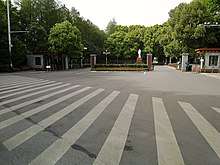
Wuhan is a sub-provincial city. Municipal government is regulated by the local Communist Party of China (CPC), led by the Wuhan CPC Secretary (Chinese: 武汉市委书记), Wang Zhonglin (王忠林). The local CPC issues administrative orders, collects taxes, manages the economy, and directs a standing committee of the Municipal People's Congress in making policy decisions and overseeing the local government.
Government officials include the mayor (市长), Zhou Xianwang (周先旺), and vice-mayors. Numerous bureaus focus on law, public security, and other affairs.
Administrative divisions
The sub-provincial city of Wuhan currently comprises 13 districts.[128] As of the Sixth Census of China in 2010, the 13 districts comprised 160 township-level divisions including 156 subdistricts, 3 towns, 1 townships.[6][7]
| Map | District | Chinese (S) | Pinyin | Population (2010 census)[129][6][7] |
Area (km2)[9] | Density (/km2) |
|---|---|---|---|---|---|---|
| Central Districts | 6,434,373 | 888.42 | 7,242 | |||
| Jiang'an | 江岸区 | Jiāng'àn Qū | 895,635 | 64.24 | 13,942 | |
| Jianghan | 江汉区 | Jiānghàn Qū | 683,492 | 33.43 | 20,445 | |
| Qiaokou | 硚口区 | Qiáokǒu Qū | 828,644 | 46.39 | 17,863 | |
| Hanyang | 汉阳区 | Hànyáng Qū | 792,183[130] | 108.34 | 7,312 | |
| Wuchang | 武昌区 | Wǔchāng Qū | 1,199,127 | 87.42 | 13,717 | |
| Qingshan | 青山区 | Qīngshān Qū | 485,375 | 68.40 | 7,096 | |
| Hongshan | 洪山区 | Hóngshān Qū | 1,549,917[131] | 480.20 | 3,228 | |
| Suburban and Rural Districts | 3,346,271 | 7,605.99 | 440 | |||
| Dongxihu | 东西湖区 | Dōngxīhú Qū | 451,880 | 439.19 | 1,029 | |
| Hannan | 汉南区 | Hànnán Qū | 114,970 | 287.70 | 400 | |
| Caidian | 蔡甸区 | Càidiàn Qū | 410,888 | 1,108.10 | 371 | |
| Jiangxia | 江夏区 | Jiāngxià Qū | 644,835 | 2,010.00 | 321 | |
| Huangpi | 黄陂区 | Huángpí Qū | 874,938 | 2,261.00 | 387 | |
| Xinzhou | 新洲区 | Xīnzhōu Qū | 848,760 | 1,500.00 | 566 | |
| Water Region (水上地区) | 4,748 | - | - | |||
| Total | 9,785,392 | 8,494.41 | 1,152 | |||
Diplomatic missions
There are four countries that have consulates in Wuhan:
| Consulate | year | Consular District |
|---|---|---|
| October 10, 1998 | Hubei/Hunan/Jiangxi | |
| November 20, 2008 | Hubei/Hunan/Henan/Jiangxi | |
| October 25, 2010 | Hubei/Hunan/Henan/Jiangxi | |
| January 8, 2015 | Hubei/Henan |
The current U.S. Consul General, the Honorable Mr. Jamie Fouss, was posted to Wuhan in August 2017. The office of the U.S. Consulate General, Central China (located in Wuhan) celebrated its official opening on November 20, 2008 and is the first new American consulate in China in over 20 years.[136][137] The consulate is currently scheduled to offer visa and citizen services in the Fall of 2018.
In 2015, Japan[138] and Russia[139] announced their intentions to establish consular offices in Wuhan.
Economy

Up until the 21st century, Wuhan was largely an agricultural region. Since 2004 it has been a focal point of the Rise of Central China Plan, which aims to build less-developed inland economies into hubs of advanced manufacturing.
Since 1890,[116] the steel industry has been the backbone of Wuhan's industry.[140] In 2010, automobile industry exceeded GDP for Wuhan Iron and Steel Corporation (WISCO) steel for the first time. There are 5 car manufacturers, including Dongfeng Honda, Citroen, Shanghai GM, DFM Passenger Vehicle and Dongfeng Renault. Dongfeng-Citroen Automobile Co., Ltd is headquartered in the city.[140]
As of 2016, Wuhan has attracted foreign investment from over 80 countries, with 5,973 foreign-invested enterprises established in the city with a total capital injection of $22.45 billion USD.[141] Among these, about 50 French companies including Renault and PSA Group have operations in the city, representing over one third of French investment in China, and the highest level of French investment in any Chinese city.[142]
Wuhan is an important center for economy, trade, finance, transportation, information technology, and education in China. Its major industries include optic-electronic, automobile manufacturing, iron and steel manufacturing, new pharmaceutical sector, biology engineering, new materials industry and environmental protection. Environmental sustainability is highlighted in Wuhan's list of emerging industries, which include energy efficiency technology and renewable energy.[141]
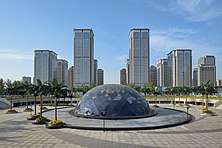
Industrial zones
Major industrial zones in Wuhan include in chronological order:
- Wuhan Economic and Technological Development Zone
Wuhan Economic and Technological Development Zone is a national level industrial zone incorporated in 1993.[143] Its current zone size is about 10–25 square km and it plans to expand to 25–50 square km. Industries encouraged in Wuhan Economic and Technological Development Zone include Auto-mobile Production/Assembly, Biotechnology/Pharmaceuticals, Chemicals Production and Processing, Food/Beverage Processing, Heavy Industry, and Telecommunications Equipment.
- Wuhan Export Processing Zone
Wuhan Export Processing Zone was established in 2000. It is located in Wuhan Economic and Technology Development Zone, planned to cover 2.7 square kilometers (1.0 square mile) of land. The first 0.7-square-kilometer (0.3-square-mile) area has already been created.[144]
Wuhan Donghu New Technology Development Zone is a national level high-tech development zone. Optical-electronics, telecommunications, and equipment manufacturing are the core industries of Wuhan East Lake High-Tech Development Zone (ELHTZ) while software outsourcing and electronics are also encouraged. ELHTZ is China's largest production center for optoelectronic products with key players like Yangtze Optical Fiber and Cable,[145] (the largest fiber-optical cable maker in China), and Fiberhome Telecommunications.[146] Wuhan Donghu New Technology Development Zone also represents the development center for China's laser industry with key players such as HG Tech[147] and Chutian Laser being based in the zone.[148]
- Wuhan Optical Valley (Guanggu) Software Park
Wuhan Optical Valley (Guanggu) Software Park is located in Wuhan Donghu New Technology Development Zone. Wuhan Optics Valley Software Park is jointly developed by East Lake High-Tech Development Zone and Dalian Software Park Co., Ltd.[149] The planned area is 0.67 square kilometers (0.26 square miles) with total floor area of 6,000,000 square meters (65,000,000 square feet). The zone is 8.5 km (5.28 mi) away from the 316 National Highway and is 46.7 km (29.02 mi) away from the Wuhan Tianhe Airport.
- Wuhan Biolake
Biolake is an industrial base established in 2008 in the Optics Valley of China. Located in East Lake New Technology Development Zone of Wuhan, Biolake covers 15 km2 (5.8 sq mi), and has six parks including Bio-innovation Park, Bio-pharma Park, Bio-agriculture Park, Bio-manufacturing Park, Medical Device Park and Medical Health Park, to accommodate both research activities and living.[150][151][152][153][154]
Demographics
| Year | Pop. | ±% |
|---|---|---|
| 1953 | 1,427,300 | — |
| 1982 | 4,101,000 | +187.3% |
| 1990 | 6,901,911 | +68.3% |
| 2000 | 8,312,700 | +20.4% |
| 2007 | 7,243,000 | −12.9% |
| 2010 | 9,785,388 | +35.1% |
| 2014 | 10,338,000 | +5.6% |
| 2015 | 10,607,700 | +2.6% |
| Population size may be affected by changes on administrative divisions. 1953,[155][156] 1982,[157] 1990,[158] 2000 [129] 2007[159] 2015[160] | ||
Wuhan is the most populous city in Central China and among the most populous in China. In the Sixth Census of China in 2010, Wuhan's built-up area made of 8 out of 10 urban districts (all but Xinzhou and Hannan not yet conurbated) was home to 8,821,658 inhabitants.[161] As of 2015, the city of Wuhan had an estimated population of 10,607,700 people.[160]
The encompassing metropolitan area was estimated by the OECD (Organization for Economic Cooperation and Development) to have, as of 2010, a population of 19 million.[162][12] As of November 2019, urban development status considering both spatial and socioeconomic processes has been examined using Night Time Lighting data and land cover data as proxies; it showed Wuhan's high concentration of socioeconomic activities compared to its urban spatial development.[163]
Religion
Religion in Wuhan (2017)[164]
According to a survey published in 2017, 79.2% of the population of Wuhan are either irreligious or practice worship of gods and ancestors; among these 0.9% are Taoists. Among other religious doctrines, 14.7% of the population adheres to Buddhism, 2.9% to Protestantism, 0.3% to Catholicism and 1.6% to Islam, and 1.6% of the population adheres to unspecified other religions.[164]
- Religious sites in Wuhan
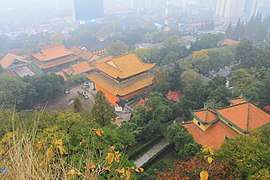 Baotong Buddhist Temple
Baotong Buddhist Temple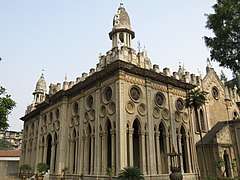 Gude Buddhist Temple
Gude Buddhist Temple- Thanksgiving Protestant Church
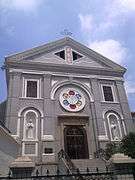 Holy Family Catholic Church
Holy Family Catholic Church
Transportation
Railways

China Railway Wuhan Group manages the Wuhan Railway Hub. Wuhan Railway Hub is considered one of the four key railway hubs of China.[165] The city of Wuhan is served by three major railway stations: the Hankou Railway Station in Hankou, the Wuchang Railway Station in Wuchang, and the Wuhan Railway Station, located in a newly developed area east of the East Lake (Hongshan District). As the stations are many miles apart, it is important for passengers to be aware of the particular station(s) used by a particular train.
The (original) Hankou Station was the terminus for the Jinghan Railway from Beijing, while the Wuchang Station was the terminus for the Yuehan Railway to Guangzhou. Since the construction of the First Yangtze Bridge and the linking of the two lines into the Jingguang Railway, both Hankou and Wuchang stations have been served by trains going to all directions, which contrasts with the situation in such cities as New York or Moscow, where different stations serve different directions.
With the opening of the Hefei-Wuhan high-speed railway on April 1, 2009,[166] Wuhan became served by high-speed trains with Hefei, Nanjing, and Shanghai; several trains a day now connect the city with Shanghai, getting there in under 6 hours. As of early 2010, most of these express trains leave from the Hankou Railway Station.
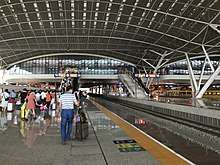
In 2006, construction began on the new Wuhan Railway Station with 11 platforms, located on the northeastern outskirts of the city. In December 2009, the station was opened, as China unveiled its second high-speed train with scheduled runs from Guangzhou to Wuhan. Billed as the fastest train in the world, it can reach a speed of 394 km/h (244.82 mph). The travel time between the two cities has been reduced from ten and a half hours to just three. The rail service has been extended north to Beijing.[167]
As of 2011, the new Wuhan Railway Station is primarily used by the Wuhan-Guangzhou high-speed trains, while most regular trains to other destinations continue to use the Hankou and Wuchang stations.
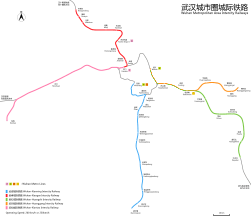
Construction work is carried out on several lines of the new Wuhan Metropolitan Area Intercity Railway, which will eventually connect Wuhan's three main rail terminals with several stations throughout the city's outer areas and farther suburbs, as well as with the nearby cities of Xianning, Huangshi, Huanggang, and Xiaogan. The first line of the system, the one to Xianning, opened for passenger operations at the end of 2013. The line to Xiaogen opened on 1 December 2016 and it was extended with the opening of the Wuhan–Shiyan high-speed railway to Shiyan on 29 November 2019.[168][169]
The main freight railway station and classification yard of the Wuhan metropolitan area is the extensive Wuhan North railway station, with 112 tracks and over 650 switches. It is located in Hengdian Subdistrict of Huangpi District, located 20 km (12 mi) north of the Wuhan Station and 23 km (14 mi) from Hankou Station.
Wuhan Metro

Wuhan Metro is a rapid transit system serving the city of Wuhan. Owned and operated by Wuhan Metro Group Co., Ltd., the network now includes 9 lines, 228 stations, and 339 km (211 mi) of route length. Line 1, the first line in the system, opened on 28 July 2004, which made Wuhan the seventh city in mainland China with rapid transit system, after Beijing, Tianjin, Shanghai, Guangzhou, Changchun, and Dalian.[170] Line 2 opened on 28 December 2012 and is the first underground metro line crossing the Yangtze River. Commuting across the Yangtze River and Han River has been the bottleneck of Wuhan traffic. However, the appearance of Wuhan Metro greatly relieved this problem. With 1.22 billion annual passengers in 2019, Wuhan Metro is the sixth-busiest rapid transit system in mainland China.[171] There are a number of lines or sections under construction. The government of Wuhan City promised the citizens that at least two lines or sections open every year.[172] Due to the COVID-19 pandemic, the entire network was out of service from 23 January to 27 March 2020.
Trams
Trams were brought to the streets of Wuhan on July 28, 2017 with the first line (Auto-city T1 Line) opened that day.[173] The trams under construction or planning in Wuhan are:
- Auto-city trams, with Lines T1, T2, T6, and T8 in the Wuhan Economic Development Area, in the far western reaches on Hanyang. T1 Line is operational as of 2017.
- Optics Valley trams, two lines (T1 and T2) south and east of Guanggu Circle (Guanggu Guangchang) in southeastern Wuchang. The system opened on January 18, 2018.[174]
- The Old Hankou Streetcar, a loop line around Hankou city.
Maritime transport
Wuhan is a major hub for maritime transport in central China. The Port of Wuhan provide services for the local population and shipping services.
Ferry
As a city located at bank of Yangtze River, Wuhan has long history of ferry services. Modern ferry services were established in 1900 by steam boat. In 1937, a train ferry was established to transport train cars from Hankou to Wuchang.[175] There are numbered stops around Wuhan where people can get on and off the ferry and there is a tourist ferry in the night.
Currently, ferry services are provided by the Wuhan Ferry Company. In 2010, the company bought 10 new ships to replace the ones that had been in service for 29 years.[176]
Airports
.jpg)
Opened in April 1995 to substitute for the old Hankou Wangjiadun Airport and Nanhu Airport as the major airport of Wuhan,[177][178] Wuhan Tianhe International Airport is one of the busiest airports in central China. It is located in Wuhan's suburban Huangpi District 26 kilometers (16 mi) north of Wuhan city proper. The extension of Line 2 of Wuhan Metro to Tianhe Airport opened on 28 December 2016.[179] It has also been selected as China's fourth international hub airport after Beijing Capital International Airport, Shanghai-Pudong and Guangzhou Baiyun. A second terminal was completed in March 2008, having been started in February 2005 with an investment of CNY 3.372 billion. International flights to neighboring Asian countries have also been enhanced, including direct flights to Tokyo and Nagoya, Japan. Terminal 3 has been available for service since early 2017.
Hannan Municipal Airport is an municipal airport that serves Hannan District. It is the biggest airport in China that only handles general aviation,[180] and the biggest municipal airport in Hubei Province. Caidian Municipal Airport is an under-construction airport which will serve Caidian District. The airport began construction on 1 December 2017.[181]
Highways and expressways
Numerous major highways and expressways pass through Wuhan, including:
Bicycle-sharing system
As of May 2011, the Wuhan and Hangzhou Public Bicycle bike-share systems in China were the largest in the world, with around 90,000 and 60,000 bicycles respectively.[182] In 2012 the Wuhan and Hangzhou Public Bicycle programs in China are the largest in the world, with around 90,000 and 60,000 bicycles respectively. China has seen a rise in private "dockless" bike shares with fleets that dwarf systems in size outside China.[183] Initially, a number of traditional (third generation) docked public bike systems operated by local municipal governments opened across China, with the largest ones being in Wuhan and Hangzhou. The first was introduced in Beijing in 2007. However, third generation bike sharing is not considered successful for the majority cities in China. Bike sharing in Beijing virtually stopped and it also has encountered difficulties in Shanghai and Wuhan.[184]
Destinations
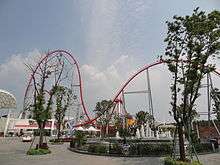
- The Yellow Crane Tower (Huanghelou) is presumed to have been first built in approximately 220 AD. The tower has been destroyed and reconstructed numerous times, and was burned last according to some sources in 1884. The tower underwent complete reconstruction in 1981. The reconstruction utilized modern materials and added an elevator while maintaining the traditional design in the tower's outward appearance.
- Wuchang has the largest and second largest lakes within a city in China, the East Lake and Tangxun Lake, as well as the South Lake. East Lake in Wuhan is six times the size of the West Lake in Hangzhou, Zhejiang province. The total area is more than 80 km2 (31 sq mi) of which the lake is covering an area of 33 km2 (13 sq mi). In the springtime, the shores of East Lake become a garden of flowers with the Mei blossoms as the king and the Cherry Blossom as the queen among the species at East Lake Cherry Blossom Park. Another famous flower is the lotus. The lake has a long history and especially the Chu Kingdom is well represented around East Lake. Moreover, in the Moshan Botanic Garden there are many types of plum blossoms, as well as lotus flowers.
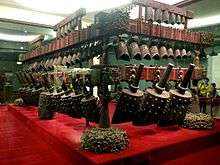
- The Hubei Provincial Museum: With over 200,000 valued artifacts, this is one of the leading museums in China. Especially the artefacts from the tomb of Marquis Yi of Zeng (Zeng Hou Yi), who lived in the 5th century BC, is a world unique treasure. The bell chime of Marquis Yi of Zeng is a bronze instrument performed 2430 years ago in ancient China (Warring States Period), and was discovered in the Tomb of Marquis Yi of Zeng in Suizhou, Hubei in 1978. The whole chime weighs 5 tons, can perfectly play sound which was heard 2430 years ago, and was considered "The Eighth Wonder of the World".
- The Wuhan Museum has a collection of more than 100,000 artifacts, including ceramic, bronze ware, paintings and calligraphy, jade, wood carving, enamel ware, seals and so on. As a modern comprehensive museum, Wuhan Museum has the function in cultural relic collection, academic reach, publicity and education, cultural exchange, and recreation and entertainment.
- Happy Valley Wuhan is a theme park in Hongshan District. Opened on 29 April 2012, it is the fifth installation of the Happy Valley theme park chain.[186]
- The Rock and Bonsai Museum includes a mounted platybelodon skeleton, many unique stones, a quartz crystal the size of an automobile, and an outdoor garden with miniature trees in the penjing ("Chinese Bonsai") style.
- Jiqing Street (吉庆街) holds many roadside restaurants and street performers during the evening and is the site of a Live Show with stories of events on this street by contemporary writer Chi Li.
- The Lute Platform in Hanyang was where the legendary musician Yu Boya is said to have played. This is the birthplace of the renowned legend of seeking a soul mate through "high mountains and flowing water". According to the story behind the Chinese word '知音' (zhīyīn; 'understanding music'), Yu Boya played for the last time over the grave of his friend Zhong Ziqi, then smashed his lute because the only person able to appreciate his music was dead.[187]
- Mao's Villa (毛澤東別墅), Mao Zedong's villa between 1960 and 1974; includes garden, living quarters, conference room, bomb shelter and swimming pool.[188][189]
- Some luxury riverboat tours begin here after a flight from Beijing or Shanghai, with several days of flatland cruising and then climbing through the Three Gorges with passage upstream past the Gezhouba and Three Gorges dams to the city of Chongqing. With the completion of the dam, a number of cruises now start from the upstream side and continue west, with tourists traveling by motorcoach from Wuhan.
- Wuying Pagoda or the "Shadowless Pagoda" is the oldest standing architectural feature in Wuhan, dating from the closing days of the Southern Song Dynasty.
- Chu River and Han Street, a shopping district located in Wuchang with many tourist attractions, including Han Show theater, Madame Tussauds wax museum, and Movie Culture Park, etc. This project was initiated as a water connecting channel between East Lake and Shahu Lake.
- Wuhan Zoo in Hanyang.[190]
- The Huanan Seafood Wholesale Market is a live animal and seafood market in the Jianghan District. The market is located in the newer part of the city near shops and apartment blocks and is close to Hankou railway station. The market has been identified as a possible point of origin of the COVID-19 pandemic.[191]
- The Wuhan Institute of Virology is located in the Wuchan District. It is, "the key laboratory of the Chinese Academy of Sciences for newly emerging and fulminating infectious disease pathogen and biosecurity."[192]
Education
Schools and universities


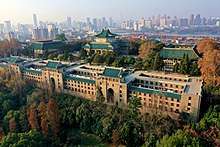
There are 35 higher educational institutions in Wuhan, making it a leading educational hub for China. Prominent institutions include Huazhong University of Science and Technology and Wuhan University. Three state-level development zones and many enterprise incubators are also significant in Wuhan's education and business development. Wuhan ranks third in China in overall strength of science and technology.[193]
As of the end of 2013, in Wuhan there were 1,024 kindergartens with 224,300 children, 590 primary schools with 424,000 students, 369 general high schools with 314,000 students, 105 secondary vocational and technical schools with 98,600 students, and 80 colleges and universities with 966,400 undergraduates and junior college students and 107,400 postgraduate students.[194] There are several international schools in Wuhan.
Huazhong University of Science and Technology (HUST), located in the Optics Valley of China near East Lake, is a Project 985 and Class A Double First Class University.[195] HUST manages Wuhan National Laboratories for Opto-electronics (WNLO), which is one of the five national laboratories in China. HUST is also one of four Chinese universities eligible to run the national laboratory and the national major science and technology infrastructure. Founded in 1953 as Huazhong Institute of Technology, it combined with three other universities (including former Tongji Medical University founded in 1907) in 2000 to form the new HUST, and has 42 schools and departments covering 12 comprehensive disciplines.[196][197] HUST has 12 Fellows of Chinese Academy of Sciences and 17 Fellows of Chinese Academy of Engineering.[198] U.S. News' 2019 U.S. News & World Report ranked HUST as 260th in the world, and 9th in China [199] while QS World University Rankings has it ranked 400th in the world.[200] More than 2,000 international students from 120 countries pursue degrees at HUST.[201]
Wuhan University is another Project 985 and Class A Double First Class University,[195] which was ranked 257th by QS World University Rankings[202] and 285th by U.S. News;[203] established in 1893, the old Wuhan University absorbed three other schools (two of them being its spin-offs since the 1950s) in 2000 to become a university with 36 schools in 6 faculties. Since the 1950s it has received international students from more than 109 countries.[204]
Scientific research
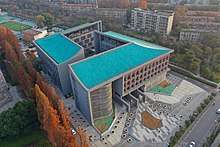
Wuhan contains three national development zones and four scientific and technological development parks, as well as numerous enterprise incubators, over 350 research institutes, 1470 high-tech enterprises, and over 400,000 experts and technicians.
Founded in 1958, the Wuhan Branch of Chinese Academy of Sciences is one of the twelve national branches of CAS. It is composed of 9 independent organizations, including the headquarters at Xiaohongshan, Wuchang. It has had a staff of 3,900, among which 8 are CAS fellows, and one is a Chinese Academy of Engineering fellow. As of 2013, the achievements gained by WHB had won 23 National Awards and 778 Provincial Awards.[205] Wuhan Research Institute of Post and Telecommunications (now known as FiberHome Technologies Group) is the national center for optical communication research in China, and is where the first optical fiber in the country was produced.[206]
Wuhan University of Technology is another major national university in the area. Founded in the year 2000, it was merged from three major universities, Wuhan University of Technology (established in 1948), Wuhan Transportation University (established in 1946) and Wuhan Automotive Polytechnic University (established in 1958). Wuhan University of Technology is one of the leading Chinese universities accredited by the Ministry of Education and one of the universities constructed with priority by "State Project 211" for Chinese higher education institutions. The University has three main campuses located in the Wuchang District.
Media
The headquarters of Hubei Television is located in Wuchang District. Tortoise Mountain TV Tower is China's first self-developed TV tower, opened in 1986. The modern newspapers in Wuhan can be dated back to 1866, when Hankow Times, a newspaper in English, was founded. Before 1949, more than 50 newspapers and magazines were published by foreigners in Wuhan. Chao-wen Hsin-pao, founded by Ai Xiaomei in 1873, was the first Chinese newspaper to appear in Hankou (one of the cities that was merged into Wuhan). During the Northern Expedition era (1926–1928), journalism in Wuhan came to a climax; more than 120 newspapers and periodicals, including national newspapers such as Central Daily News and Republican Daily News, were founded or published during this time.[207] Chutian Metropolis Daily and Wuhan Evening News are two major local commercial tabloid newspapers. Both of them have entered the list of 100 most widely circulated newspapers of the world.
Culture
The plum blossom is the city's emblem, chosen partly because of the long history of local plum cultivation and use, and partly to recognize the plum's current economic significance in terms of cultivation and research. Local wild plums were used medicinally during the Qin and Han dynasties. Cultivation of the fruit began during the Song dynasty. Some traditional new year customs revolve around the planting of plums.[16]
Language
Wuhan natives speak a variety of Southwestern Mandarin Chinese referred to as Wuhan dialect that differs slightly between the districts of Wuhan, including Wuchang dialect in Wuchang District, Hankou dialect in the Hankou districts, Hanyang dialect in Hanyang District, and Qingshan dialect in Qingshan District.
Cuisine

Hubei cuisine is one of China's ten major styles of cooking. With a history of more than 2,000 years, Hubei cuisine, originating in ancient Chu cuisine, has developed a number of distinctive dishes, such as steamed blunt-snout bream in clear soup, preserved ham with flowering Chinese cabbage, and others. On the third day of the third month of the lunar calendar, many in Wuhan eat dìcài zhǔ jīdàn (地菜煮鸡蛋), an egg dish which is supposed to prevent illness in the coming year.[208]
"No need to be particular about the recipes; all foods have their own uses. Rice wine and tangyuan are excellent midnight snacks, while fat bream and flowering Chinese cabbages are great delicacies."[209] This attitude expressed in Hankou Zhuzhici reflects indirectly the eating habits and a wide variety of distinctive snacks with a long history in Wuhan, such as Qingshuizong (a pyramid-shaped dumpling made of glutinous rice wrapped in bamboo or reed leaves) in the Period of the Warring States, Chunbinbian in Northern and Southern dynasties, mung bean jelly in the Sui dynasty, youguo (a deep-fried twisted dough stick) in the Song and Yuan dynasties, rice wine and mianwo in the Ming and Qing dynasties, as well as three-delicacy stuffed skin of bean milk, tangbao (steamed dumpling filled with minced meat and gravy) and hot braised noodles (reganmian) in modern times.
Guozao (過早) is a popular way to say 'having breakfast' in Wuhan,[210] and a part of the city's culture. As a hub for land transport in China, Wuhan has gathered and mixed together various habits and customs from neighboring cities and provinces in all directions, which gives rise to a concentration of diverse cuisines from different places. The most famous place to guozao (have breakfast) is Hubu Street (戶部巷), a 150-meter-long street in the neighborhood of Simenkou (司门口). Along its short length one can find nearly all the traditional foods of Wuhan, such as:
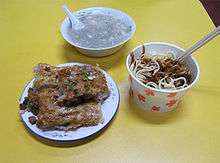
- Hot and dry noodles, re-gan mian (热干面), consists of long freshly boiled noodles mixed with sesame paste. It is considered to be the most typical local food for breakfast.
- Duck's neck or Ya Bozi (鸭脖子) is a local version of this popular Chinese dish, made of duck necks and spices.
- Bean skin or doupi (豆皮) is a local dish with a filling of egg, rice, beef, mushrooms and beans cooked between two large round soybean skins and cut into pieces, structurally like a stuffed pizza without enclosing edges.
- Soup dumpling or xiaolongtangbao (小笼汤包) is a kind of dumpling with thin skin made of flour, steamed with very juicy meat inside, hence the name: tang (soup) bao (bun) – every time one takes a bite from it the "soup" inside is liable to spill out.
- A salty doughnut or mianwo (麪窩) is a kind of savory donut with a salty taste. It is much thinner than a common donut and is a typical Wuhan local food.
Opera
Han opera, which is the local opera of Wuhan area, was one of China's oldest and most popular operas. During the late Qing dynasty, Han opera, blended with Hui opera, gave birth to Peking opera, the most popular opera in modern China. Thus Han opera has been called the "mother of Peking opera."[211][212]
Sports
Wuhan has a professional football team, Wuhan Zall F.C., that plays in the Chinese Super League. Xinhua Road Sport Center, the team's home stadium, with a capacity of 32,137, is located in the heart of the city next to Zhongshan Park. For the 2013 season, Wuhan Zall was promoted to the top-tier league of Chinese football, Chinese Super League, and relocated its home to Wuhan Sports Center Stadium, a modern stadium with 54,357 seats located in the suburbs of the city. However, the team did not play well in the ensuing season and was demoted back to China League One as the 2013 season ended. For financial and transportation reasons, the team moved back to Xinhua Road Sport Center in 2014.
The Wuhan Gators are a professional arena football team based in Wuhan. They are members of the China Arena Football League (CAFL).[213]
The 13,000-seat Wuhan Gymnasium held the 2011 FIBA Asia Championship and was one of the venues for the 2019 FIBA Basketball World Cup.[214] The 7th Military World Games were hosted in Wuhan from Oct. 18 to 27, 2019.[215][216]
The city has been the venue for the women's tennis tournament, the Wuhan Open, one of the WTA's Premier 5 tournaments, since 2014.
Architecture
Bridges
Wuhan has eleven bridges and one tunnel across the Yangtze River. The Wuhan Yangtze River Bridge, also called the First Bridge, was built over the Yangtze in 1957, carrying a railroad directly across the river between hills known as Snake Hill and Turtle Hill. Before this bridge was built it could take up to an entire day to barge railcars across. Including its approaches, it is 5,511 feet (1,680 m) long, and it accommodates both a double-track railway on a lower deck and a four-lane roadway above. It was built with the assistance of advisers from the Soviet Union.
The Second Bridge, a cable-stayed bridge built of prestressed concrete, has a central span of 400 meters (1,300 feet); it is 4,678 meters (15,348 feet) in length (including 1,877 meters (6,158 feet) of the main bridge) and 26.5 to 33.5 meters (86.9 to 109.9 feet) in width. Its main bridgeheads are 90 meters (300 feet) high each, pulling 392 thick slanting cables together in the shape of double fans so that the central span of the bridge is well poised on the piers and the bridge's stability and vibration resistance are ensured. With six lanes on the deck, the bridge is designed to handle the daily passage of 50,000 motor vehicles. The bridge was completed in 1995.

The Third Wuhan Yangtze River Bridge, also called Baishazhou Bridge, was completed in September 2000. Located 8.6 kilometers (5.3 miles) southwest of the First Bridge, construction of Baishazhou Bridge started in 1997. With an investment of over 1.4 billion yuan (about US$170,000,000), the bridge, which is 3,586 meters (11,765 feet) long and 26.5 meters (86.9 feet) wide, has six lanes and has a capacity of 50,000 vehicles a day. The bridge is expected to serve as a major passage for the future Wuhan Ring Road, greatly easing the city's traffic and aiding local economic development.
The Yangluo Bridge carries Wuhan's Ring Road across the Yangtze in the city's eastern suburbs (connecting the Hongshan District with the Xinzhou District). It was opened on December 26, 2007.
The Wuhan Tianxingzhou Yangtze River Bridge crosses the Yangtze in the northeastern part of the city, downstream of the Second bridge. It is named after Tianxing Island (Tianxingzhou), above which it crosses the river. Built at a cost of 11 billion yuan, the 4,657-meter cable suspension bridge was opened on December 26, 2009,[217] in time for the opening of the Wuhan Railway Station. It is a combined road and rail bridge, and carries the Wuhan–Guangzhou High-Speed Railway across the river.
Skyscrapers
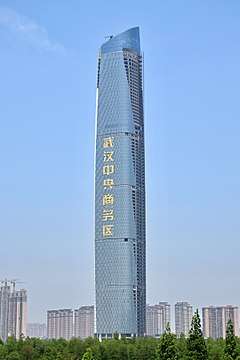
The Yellow Crane Tower, historically one of the tallest buildings in Wuhan, is considered one of the Four Great Towers of China and was destroyed twelve times, both by warfare and by fire. The tower is classified as an AAAAA scenic area by the China National Tourism Administration.[218] At 438 meters (1,437 ft) in height,[219] the Wuhan Center skyscraper, the tallest structure in Wuhan and in Central China, is the eighth tallest structure in China. The Minsheng Bank Building, the second tallest structure in Wuhan, was the tallest building in Wuhan when it was completed in 2007. It retained the title until Wuhan Center surpassed it in 2014.[220][221] Wuhan World Trade Tower is a 273-meter (896 foot) tall skyscraper located in Wuhan. It became the tallest building in Wuhan after its completion in 1998. However, it was surpassed by the Minsheng Bank Building in 2007.
The Wuhan Greenland Center[222] is a planned 636-meter (2,087 ft), 126-floor mixed-use skyscraper currently under construction and scheduled for completion in 2019. If completed as planned, it will be among the world's tallest structures, and one of the world's tallest buildings by occupiable floor height. The Phoenix Towers are proposed supertall skyscrapers planned for construction in Wuhan. At 1 kilometer (3,300 ft) high, the towers would also be among the tallest structures in the world when completed.[223]
Notable Wuhanese
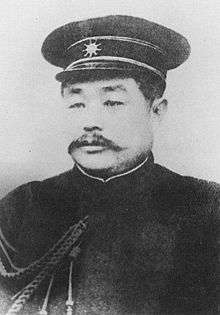
Politics
- Li Yuanhong – former President of the Republic of China (1916–17, 1922–23).
- Wu Yi – former Vice-Premier and Minister of Health of the People's Republic of China[224]
Business
- Wei Brian – Chinese entrepreneur
Science
- Chang-Lin Tien – seventh Chancellor of the University of California, Berkeley (1990–1997) and a major founder of the U.S. National Academy of Engineering (NAE). Professor Tien is the first Asian to head a top university in the United States.
- E Dongchen – "father of polar surveying and mapping" in China
- Weiping Zou – Charles B. de Nancrede Professor of Pathology, Immunology, Biology, and Surgery at the University of Michigan, American Association for Cancer Research Cancer Immunology (CIMM) Chairperson 2018–2019, Abstract Programming Chair for the American Association of Immunologists
Sports
- Deng Zhuoxiang – professional football player, scored many impressive goals for Chinese national team in important games including 3:0 South Korea and 1:0 France in 2010.
- Fu Mingxia – female diver, four-time Olympic Gold Medalist (one in Barcelona 1992, two in Atlanta 1996, one in Sydney 2000), the only diver that has won gold medals at three Olympics as well as one of the very few divers in the world who is able to win world championships in both platform diving and springboard diving.
- Gao Ling – professional badminton player, two-time Olympic gold medalist (Sydney 2000, Athens 2004).
- Hao Junmin – professional football player, played for Schalke 04 in the German League.
- Hu Jia – Chinese diver who won the gold medal at the 2004 Summer Olympics in the men's 10 meter platform.
- Mei Fang – Chinese footballer playing for Guangzhou Evergrande in the Chinese Super League.
- Li Na – female tennis player, champion of the French Open 2011 and Australian Open 2014.
- Li Ting – tennis player, Olympic gold medalist (in women's doubles, Athens 2004).
- Qiao Hong – female table tennis player, two-time Olympic gold medalist (in women's doubles, Barcelona 1992, Atlanta 1996).
- Rong Hao – professional football player, with six Chinese Super League titles and two AFC Champions League champion titles.
- Tang Jieli – AIBA Women's Boxing World Champion.[225]
- Xiao Hailiang – Chinese diver, Olympic gold medalist (in 3-meter (9.8-foot) springboard synchronized diving, Sydney 2000).
- Zeng Cheng – professional football player, with six Chinese Super League titles and two AFC Champions League champion titles.
- Zhou Jihong – female diver, Olympic gold medalist (Los Angeles 1984), the first Chinese athlete to win an Olympic gold medal in diving.
- Tian Tao – Olympic weightlifter
- Lü Xiaojun – Olympic weightlifter
Arts
- Chi Li – writer[226]
- Ying Chang Compestine, a Chinese American author, speaker, television host and chef
- Liu Yifei – actress and singer. Childhood friend with Yao Beina
- Peng Xiuwen – composer and conductor
- Tian Yuan – singer and actress
- Paula Tsui – singer who spent most of her singing career in Hong Kong
- Wang Kai – actor
- Zhou Mi – musician, member of the band Super Junior M
- Zhu Yilong – actor
- Yao Beina – singer, (during 2005–2015) known as the "Voice of China", spiritual leader of organ donation and charity (1981–2015).
- Xu Fan – actress
- Yan Wenjing – writer whose work is included as one of the literary selections on the Putonghua Proficiency Test.
- Wang Xiaosong – artist who studied in Germany and is now professor at Zhejiang University in Hangzhou
- Han Dong – Musician, member of the Kpop group Dreamcatcher
Other fields
- Saint Francis Regis Clet, who was martyred here
- Hua Mulan – Ancient Chinese heroine whose story has been passed through ages in China and has been presented in a great number of books and motion pictures, including the Disney animated feature Mulan (1998)
- Samuel David Hawkins – American soldier in the Korean War who was captured by the North, subsequently defected to China at the time of the Korean Armistice Agreement. He worked as a mechanic in Wuhan before returning to the US in 1957.
- Wu Shuqing – female revolutionary and militia leader during the Xinhai Revolution
- Xiong Bingkun (熊秉坤) – the soldier who started and led the Wuhan Uprising in the Chinese Revolution of 1911 which gave birth to the Republic of China, Asia's first republic country.
- Zhong Ziqi – The best friend of Yu Boya, an ancient Chinese musician whose musical composition "Flowing Water" was included on the Voyager Golden Record
Sister cities
Wuhan is twinned with:[227]
| City | Country | Since |
|---|---|---|
| September 7, 1979 | ||
| September 8, 1982 | ||
| October 8, 1982 | ||
| September 16, 1986[228] | ||
| August 12, 1987 | ||
| October 19, 1990 | ||
| Khartoum | September 27, 1995 | |
| October 19, 1995 | ||
| June 18, 1998 | ||
| September 6, 1999 | ||
| October 29, 2000 | ||
| December 20, 2005 | ||
| April 4, 2006 | ||
| Markham | September 12, 2006 | |
| April 25, 2008 | ||
| November 8, 2011 | ||
| December 21, 2012 | ||
| İzmir | June 6, 2013 | |
| July 12, 2013[234] | ||
| August 7, 2015 | ||
| April 7, 2016 | ||
| November 15, 2016 | ||
| May 11, 2017 | ||
| June 16, 2017 | ||
| Swansea[237] | January 31, 2018 | |
| Entebbe | April 13, 2018 | |
| November 16, 2018 |
And Wuhan has friendly exchange relationships with:[239]
| City | Country | Since |
|---|---|---|
| February 16, 1998 | ||
| October 17, 2003 | ||
| St. Louis | September 27, 2004 | |
| September 9, 2006 | ||
| Daejeon | November 1, 2006 | |
| Gwangju | September 6, 2007 | |
| Kolkata | July 24, 2008 | |
| Suwon | December 5, 2008 | |
| Taebaek | December 5, 2008 | |
| October 30, 2009 | ||
| November 6, 2009 | ||
| November 10, 2009 | ||
| Cebu City | August 19, 2011 | |
| November 12, 2011 | ||
| September 10, 2012 | ||
| September 20, 2012 | ||
| November 6, 2012 | ||
| September 18, 2012 | ||
| July 16, 2013 | ||
| November 21, 2013 | ||
| Siem Reap Province | November 21, 2013 | |
| Biratnagar | November 21, 2013 | |
| November 21, 2013 | ||
| March 14, 2014 | ||
| April 11, 2014 | ||
| May 30, 2014 | ||
| June, 2014 | ||
| June 23, 2014 | ||
| June 23, 2014 | ||
| June 23, 2014 | ||
| June 23, 2014 | ||
| Hayward | June 23, 2014 | |
| June 23, 2014 | ||
| Moraga | June 23, 2014 | |
| June 23, 2014 | ||
| Mountain View | June 23, 2014 | |
| June 23, 2014 | ||
| Union City | June 23, 2014 | |
| June 25, 2014 | ||
| August 25, 2014 | ||
| August 27, 2014 | ||
| Patan | October 20, 2014 | |
| October 24, 2014 | ||
| October 24, 2014 | ||
| October 24, 2014 | ||
| October 29, 2014 | ||
| November 3, 2014 | ||
| November 24, 2014 | ||
| December 11, 2014 | ||
| Cape Town | December 9, 2014 | |
| April 29, 2015 | ||
| May 7, 2015 | ||
| May 20, 2015 | ||
| July 4, 2015 | ||
| Gold Coast | September 29, 2015 | |
| November 1, 2015 | ||
| December 3, 2015 | ||
| Galle | December 5, 2015 | |
| Mungyeong | December 22, 2015 | |
| Daegu | March 25, 2016 | |
| Tacoma | April 5, 2016 | |
| April 8, 2016 | ||
| Tabriz | May 28, 2016 | |
| Marrakesh | June 3, 2016 | |
| July 11, 2016 | ||
| September 5, 2016 | ||
| September 10, 2016 | ||
| Jinja | September 20, 2016 | |
| September 20, 2016 | ||
| Maribor | September 23, 2016 | |
| Montego Bay | September 28, 2016 | |
| Victoria | October 17, 2016 | |
| November 25, 2016 | ||
| December 16, 2016 | ||
| March 9, 2017 | ||
| March 20, 2017 | ||
| May 10, 2017 | ||
| August 29, 2017 | ||
| November 14, 2017 | ||
| November 20, 2017 | ||
| May 21, 2018 | ||
| Fergana | October 14, 2018 |
Nature and wildlife
In Chinese mythology, the Baiji ("Yangtze River dolphin") has many origin stories. In one legend, the Baiji was the daughter of a general who was deported from the city of Wuhan during a war. During his duty, the daughter ran away. Later, the general met a woman who told him how her father was a general, and when he realized that she was his daughter, he threw himself into the river out of shame. The daughter ran after him and also fell into the river. Before they were drowned, the daughter was transformed into a dolphin, and the general a porpoise.[240]
See also
- Historical capitals of China
- List of cities in the People's Republic of China by population
- List of current and former capitals of subnational entities of China
References
- "Archived copy" 图文:"黄金十字架"写就第一笔. Sina. March 30, 2009. Archived from the original on March 4, 2016. Retrieved February 21, 2018.
武汉历史上就是"九省通衢",在中央促进中部崛起战略中被定位为"全国性综合交通运输枢纽"。
CS1 maint: archived copy as title (link) - 九省通衢. The government of Wuhan. Archived from the original on November 27, 2012. Retrieved May 5, 2019.
- "Foreign News: On To Chicago". Time. June 13, 1938. Archived from the original on January 5, 2012. Retrieved November 20, 2011.
- Jacob, Mark (May 13, 2012). "Chicago is all over the place". Chicago Tribune. Archived from the original on May 11, 2013. Retrieved May 22, 2012.
- 水野幸吉 (Mizuno Kokichi) (2014). 中国中部事情:汉口 [Central China: Hankou]. Wuhan Press. p. 3. ISBN 9787543084612.
- "Archived copy" 武汉市历史沿革 (in Chinese). www.XZQH.org. August 6, 2014. Archived from the original on February 10, 2018. Retrieved February 10, 2018.CS1 maint: archived copy as title (link)
- "Archived copy" 行政建置 (in Chinese). Wuhan Municipal People's Government. January 8, 2018. Archived from the original on October 17, 2018. Retrieved October 17, 2018.CS1 maint: archived copy as title (link)
- "Archived copy" 武汉市信息公开. Archived from the original on April 6, 2018. Retrieved April 5, 2018.
2017年2月19日,在武汉市第十四届人民代表大会第 – 次会议上当选为武汉市政府市长
CS1 maint: archived copy as title (link) - "Wuhan Statistical Yearbook 2010" (PDF). Wuhan Statistics Bureau. Archived from the original (PDF) on November 5, 2011. Retrieved July 31, 2011.p. 15
- Cox, W (2018). Demographia World Urban Areas (PDF) (14th Annual ed.). St. Louis: Demographia. p. 22. Archived (PDF) from the original on May 3, 2018. Retrieved June 15, 2018.
- 武汉常住人口突破1100万 城市吸引力稳步提升. Xinhua Hubei 长江日报. March 26, 2019. Archived from the original on August 17, 2019. Retrieved August 17, 2019.
- OECD Urban Policy Reviews: China 2015, OECD READ edition. OECD iLibrary. OECD Urban Policy Reviews. OECD. April 18, 2015. p. 37. doi:10.1787/9789264230040-en. ISBN 9789264230033. ISSN 2306-9341. Archived from the original on March 27, 2017. Retrieved December 8, 2017. Linked from the OECD here Archived December 9, 2017, at the Wayback Machine
- 武汉市2010年国民经济和社会发展统计公报. Wuhan Statistics Bureau. May 10, 2011. Archived from the original on October 23, 2012. Retrieved July 31, 2011.
- 《2013中国人类发展报告》 (PDF) (in Chinese). United Nations Development Programme China. 2015. Archived (PDF) from the original on 29 November 2013. Retrieved 14 May 2014.
- "The Chronology of the "Living Fossil" Metasequoia Glyptostroibodes (Taxodiaceae): A Review (1943–2003)" (PDF). Harvard College. 2003. p. 15. Archived from the original (PDF) on March 6, 2016. Retrieved January 25, 2018.
1984 In the spring, Metasequoia was chosen as the 'City Tree' of Wuhan, the capital of Hubei.
- 北京奥运会火炬境内传递城市 [Beijing Olympic torch relay city within the city]. blog.sina.com.cn. March 26, 2008. Archived from the original on January 18, 2018. Retrieved January 18, 2018.
- "Illuminating China's Provinces, Municipalities and Autonomous Regions: Hubei". China.org.cn. PRC Central Government. Archived from the original on June 19, 2014. Retrieved February 19, 2018.
- "Focus on Wuhan, China". The Canadian Trade Commissioner Service. Archived from the original on December 12, 2013. Retrieved February 10, 2013.
- Zhao Manfeng (赵满丰). "Archived copy" 国家中心城市 [National central cities]. usa.chinadaily.com.cn. Archived from the original on May 20, 2018. Retrieved May 20, 2018.CS1 maint: archived copy as title (link)
- "The Wuchang Uprising on Double Ten (10/10/1911) | Britannica Blog". blogs.britannica.com. Archived from the original on April 8, 2018. Retrieved June 13, 2019.
- Stephen R. MacKinnon (2002). Remaking the Chinese City: Modernity and National Identity, 1900–1950. University of Hawaii Press. p. 161. ISBN 978-0824825188.
- "An American in China: 1936–39 A Memoir". Archived from the original on May 12, 2013. Retrieved February 10, 2013.
- Stephen R. MacKinnon (2008). Wuhan, 1938: War, Refugees, and the Making of Modern China. University of California Press. p. 12. ISBN 978-0520254459.
- "The Coronavirus: What Scientists Have Learned So Far". The New York Times. New York Times. Retrieved March 14, 2020.
- "Coronavirus Disease (COVID-19) – Research and Statistics". Our World in Data. Oxford University. Retrieved March 14, 2020.
- 武汉获批全国首个交通枢纽研究试点城市. Ministry of Commerce of the People's Republic of China. June 25, 2009. Archived from the original on December 24, 2012.
- Jing, Li (January 23, 2019). "Inside China's leading 'sponge city': Wuhan's war with water". The Guardian. ISSN 0261-3077. Archived from the original on June 13, 2019. Retrieved June 13, 2019.
- Hartley, Asit K. Biswas, Kris. "China's 'sponge cities' aim to re-use 70% of rainwater". CNN. Archived from the original on June 13, 2019. Retrieved June 13, 2019.
- Government of Canada, Foreign Affairs Trade and Development Canada (September 8, 2009). "Focus on Wuhan, China". www.tradecommissioner.gc.ca. Archived from the original on December 17, 2018. Retrieved June 13, 2019.
- 校友会2017中国大学排行榜700强揭晓,北京大学十连冠 – 艾瑞深校友会网2019中国大学排行榜,中国大学研究生院排行榜,中国 – 流大学,中国大学创业富豪榜,中国独立学院排行榜,中国民办大学排行榜. www.cuaa.net. Archived from the original on June 6, 2019. Retrieved June 13, 2019.
- "Wuhan | Creative Cities Network". en.unesco.org. Archived from the original on May 13, 2019. Retrieved June 13, 2019.
- "GaWC City Link Classification 2018". Lboro.ac.uk. November 13, 2018. Retrieved August 7, 2019.
- "Archived copy" 武汉市历史沿革 (in Chinese). XZQH.org. August 6, 2014. Archived from the original on December 11, 2017. Retrieved April 6, 2018.
1927 年1月1日,中央临时联席会议宣布,国民政府在汉口开始办公。国民政府命令将武昌、汉口、汉阳三镇合为京兆区,定名"武汉",作为临时首都。4月16日,武汉市政委员会成立,武昌市政厅撤销;三镇首次统 – 行政建制。
CS1 maint: archived copy as title (link) - 历史沿革. Archived from the original on June 25, 2012. Retrieved March 21, 2012.
- 江汉综述. Archived from the original on February 2, 2014. Retrieved March 21, 2012.
- "武汉"的由来. Archived from the original on April 25, 2012. Retrieved March 31, 2012.
- 《左传·僖公十二年》:“黄人恃诸侯之睦于齐也,不共楚职,曰:“自郢及我九百里,焉能害我?” 夏,楚灭黄。”
- "The engagement at the Red Cliffs took place in the winter of the 13th year of Jian'an, probably about the end of 208."(de Crespigny 1990:264)
- Images of the Immortal: The Cult of Lü Dongbin at the Palace of Eternal Joy by Paul R. Katz, University of Hawaii Press, 1999, p. 80
- Zizhi Tongjian vol. 71.
- http://www.ibiblio.org/chinesehistory/contents/06dat/geo.html#wuhan Archived April 8, 2018, at the Wayback Machine Hanyang was founded during the Sui dynasty (581–618); and Hankou, then known as Hsia-k'ou, during the Song (Sung) dynasty (960–1279).
- (秋,使曹休從廬江南入合肥,令寵向夏口。) Sanguozhi vol. 26.
- Wan: p. 42.
- 归元描述 – 归元禅寺. Archived from the original on February 3, 2018.
归元禅寺位于武汉市汉阳区,东眺晴川阁、南滨鹦鹉洲、北邻古琴台,占地153亩,是湖北省重点文物保护单位。由浙江僧人白光、主峰于清顺治十五年(1658 年)依王氏葵园而创建。
- Greater France: A History of French Overseas Expansion, Google Print, p. 83, Robert Aldrich, Palgrave Macmillan, 1996, ISBN 0-312-16000-3
- Kathleen L Lodwick (2009). The Chinese Recorder. BiblioBazaar, LLC. p. 414. ISBN 978-1-115-48856-3. Retrieved June 28, 2010.
- Anon (2009). Northern China, the Valley of the Blue River, Korea. 43 Maps and Plans. Read Books. p. 386. ISBN 978-1-4446-7840-6. Retrieved June 28, 2010.
- Dai, Yi (戴逸); Gong, Shuduo (龔書鐸) (2003). 中國通史. 清. Intelligence press. pp. 86–89. ISBN 962-8792-89-X.
- Fenby, Jonathan. [2008] (2008). The History of Modern China: The Fall and Rise of a Great Power. ISBN 978-0-7139-9832-0. pp. 107, 116, 119.
- Welland, Sasah Su-ling (2007). A Thousand Miles of Dreams: The Journeys of Two Chinese Sisters. Rowman Littlefield Publishing. ISBN 0-7425-5314-0, 978-0-7425-5314-9. p. 87.
- Wang, Ke-wen(1998). Modern China: An Encyclopedia of History, Culture and Nationalism. Taylor & Francis Publishing. ISBN 0-8153-0720-9, 978-0-8153-0720-4. pp. 390-391.
- Wang, Hengwei (王恆偉) (2006). 中國歷史講堂 #6 民國.. Zhonghua Book Company. pp. 3–7. ISBN 962-8885-29-4.
- Spence, Jonathan D. (1990). The Search for Modern China. W. W. Norton & Company. ISBN 0-393-30780-8, 978-0-393-30780-1. pp. 250–256.
- Harrison Henrietta (2000). The Making of the Republican Citizen: Political Ceremonies and Symbols in China, 1911–1929. Oxford University Press. ISBN 0-19-829519-7, 978-0-19-829519-8. pp. 16–17.
- Bergere, Marie-Claire. Lloyd Janet (2000). Sun Yat-sen. Stanford University Press. ISBN 0-8047-4011-9, 978-0-8047-4011-1. p. 207.
- "Archived copy" 雙十節是? 陸民眾:「國民黨」國慶 (in Chinese). TVBS. Archived from the original on November 10, 2014. Retrieved October 8, 2011.CS1 maint: archived copy as title (link)
- Taylor 2009, p. 68.
- Robert Jackson Alexander, International Trotskyism, 1929–1985: A Documented Analysis of the Movement (Duke University Press, 1991) p. 206
- Taylor 2009, p. 72.
- Harrison, The Long March to Power, p. 111
- Clark, Anne Biller. Clark, Anne Bolling. Klein, Donald. Klein, Donald Walker (1971). Harvard Univ. Biographic Dictionary of Chinese communism. Original from the University of Michigan v.1. Digitized Dec 21, 2006. p. 134.
- William Graves (1982). The Torrent of Life (Journey into China) (5th ed.). National Geographic Society. ISBN 978-0-87044-437-1.
- Chris Courtney (2018). The Nature of Disaster in China: The 1931 Yangzi River Flood. Cambridge University Press. ISBN 978-1-108-41777-8.
- Pietz, David (2002). Engineering the State: The Huai River and Reconstruction in Nationalist China 1927–1937. Routledge. ISBN 0-415-93388-9. pp. xvii, 61–70.
- Winchester, Simon (2004). The River at the Center of the World: A Journey Up the Yangtze, and Back in Chinese Time. Macmillan. ISBN 0-312-42337-3.
- 'http://eresources.nlb.gov.sg/newspapers/Digitised/Searchresults.aspx?q=%E7%8E%8B%E5%8F%94%E9%87%91&ct=article&ct=advertisement&ct=illustration&ct=letter&df=01%2F01%2F1923&dt=31%2F12%2F1970&t=nysp&mode=advanced&lang Archived January 31, 2016, at the Wayback Machine
- Nanyang Siang Pau. Kuala Lumpur, 1940, p. 13
- Nanyang Siang Pau. Kuala Lumpur, 2 September 1935, p. 8
- Nanyang Siang Pau. Kuala Lumpur, 1938, p. 14
- "Archived copy". Archived from the original on August 6, 2014. Retrieved June 28, 2014.CS1 maint: archived copy as title (link)
- "CCTVPLUS". newscontent.cctv.com.
- "Archived copy". Archived from the original on February 18, 2018. Retrieved February 18, 2018.CS1 maint: archived copy as title (link)
- Fenby, Jonathan Chiang Kai-Shek China's Generalissimo and the Nation He Lost, New York: Carroll & Graf, 2004 p. 447.
- "The US Firebombing of Wuhan, Part 2". September 16, 2015. Archived from the original on February 18, 2018. Retrieved February 18, 2018.
- 皮明庥,郑自来 2011, pp. 108–109
- 三联生活周刊. "Archived copy" 1949年5月的武汉_三联生活周刊. www.lifeweek.com.cn. Archived from the original on February 18, 2018. Retrieved February 18, 2018.
在 – 片树林里找到了解放军118师的师部,然后带着部队走进了武汉,进武汉市的时候已经是18点了"。{...}16日,解放军进城,{...}5月16日17点,张林苏就进了武汉。
CS1 maint: archived copy as title (link) - Hu, Puchen (胡甫臣) (1981). 武汉地下斗争回忆录. Hubei People's Press. p. 383. 统 – 书号 (National Standard Book Number of China) 11106·136.
共军于下午二时初刻自两端入城
- 陈芳国 (2009). 武汉解放述略. 武汉文史资料 (4): 4–10.
- ""Swimming" by Mao Zedong". Marxists.org. Archived from the original on September 12, 2009. Retrieved August 1, 2009.
- 1917-, Li, Rui; 1917-, 李锐 (2007). Li Rui wen ji. [Xianggang]: Xianggang she hui ke xue jiao yu chu ban you xian gong si. ISBN 978-9889958114. OCLC 688480117.CS1 maint: numeric names: authors list (link)
- Thomas W. Robinson (1971). "The Wuhan Incident: Local Strife and Provincial Rebellion During the Cultural Revolution". The China Quarterly (47): 413–418. JSTOR 652320.
- Fang Wang (2016). Geo-Architecture and Landscape in China's Geographic and Historic Context: Volume 1 Geo-Architecture Wandering in the Landscape. Springer. pp. 43–. ISBN 978-981-10-0483-4. Archived from the original on March 4, 2017. Retrieved March 30, 2018.
- Zhang, Liang (2001). Nathan, Andrew; Link, Perry (eds.). The Tiananmen Papers. Public Affairs. ISBN 978-1-58648-122-3.CS1 maint: ref=harv (link)
- John Pomfret, Michael Laris (May 9, 1999). "Thousands Vent Anger in China's Cities". The Washington Post. Archived from the original on March 15, 2018. Retrieved May 7, 2019.
Xian, Wuhan and Chongqing, as well as Hong Kong, were among other cities where protests exploded.
- 祸从天降:汉江边4人被武汉坠毁飞机扫入江中 (in Chinese). Sina. June 22, 2000. Archived from the original on February 21, 2018. Retrieved January 14, 2009.
- Geoghegan, Tom (April 28, 2005). "How planes survive lightning". BBC News Magazine. BBC News. Archived from the original on February 20, 2018. Retrieved January 14, 2009.
- "Fatal Events Since 1970 for Airlines of the People's Republic of China". AirSafe.com. December 10, 2007. Archived from the original on February 20, 2018. Retrieved January 14, 2009.
- "Accident Report". Archived from the original on January 3, 2009. Retrieved February 20, 2018.
- "National flag of France with Hakenkreuz added by Chinese protesters". Reuters (in French). April 19, 2008. Archived from the original on May 25, 2011. Retrieved April 19, 2008.
- "Anti-French rallies across China" Archived February 18, 2018, at the Wayback Machine, BBC, April 19, 2008
- "National flag of France with Hakenkreuz added by Chinese protesters". Reuters (in French). April 19, 2008. Archived from the original on May 25, 2011. Retrieved April 19, 2008.
- "'Father' of China's Great Firewall Shouted Off Own Microblog – China Real Time Report". Wall Street Journal. December 20, 2010. Archived from the original on November 19, 2017. Retrieved December 25, 2010.
- "防火墙之父"北邮校长方滨兴微博遭网民"围攻" (in Chinese). Yunnan Information Times. December 23, 2010. Archived from the original on July 21, 2011. Retrieved May 20, 2011.
- "China's Great Firewall designer 'hit by shoe". BBC. May 19, 2011. Archived from the original on May 29, 2018. Retrieved May 19, 2011.
- GFW之父武汉大学演讲遭遇学生扔鞋抗议 (in Chinese). RTI. May 19, 2011. Archived from the original on November 17, 2014. Retrieved May 19, 2011.
- "Designer of Chinese web controls hit by shoe". Associated Press. May 19, 2011. Archived from the original on May 24, 2011. Retrieved May 19, 2011.
- "Chinese Student Takes Aim, Literally, at Internet Regulator". NY Times. May 19, 2011. Archived from the original on July 10, 2017. Retrieved May 20, 2011.
- 微博热点:方滨兴武汉大学遇"扔鞋"抗议?. Yunnan Information Times (in Chinese). May 19, 2011. Archived from the original on May 23, 2011. Retrieved May 20, 2011.
- "Shoe attack on China web censor sparks online buzz(AFP)". AFP. May 19, 2011. Archived from the original on August 4, 2011. Retrieved January 11, 2012.
- 三峡工程的防洪作用将提前两年实现-经济-人民网. People's Daily. Archived from the original on July 19, 2011. Retrieved August 1, 2009.
- 三峡工程防洪、通航、发电三大效益提前全面发挥. Chn-consulate-sapporo.or.jp. May 16, 2006. Archived from the original on December 25, 2007. Retrieved August 1, 2009.
- Reuters Alertnet (February 6, 2008). "CWS appeal: China winter storm response". Reuters Alertnet. Archived from the original on April 16, 2009. Retrieved February 18, 2018.
- "Heat wave sweeps parts of China – China News". SINA English. Archived from the original on July 7, 2010. Retrieved July 28, 2010.
- Associated Press, Guardian (July 28, 2010). "China's Three Gorges dam close to limit as heavy rains persist". guardian.co.uk. Archived from the original on June 22, 2018. Retrieved August 6, 2010.
- "Heavy rainfall hits Wuhan, causing waterlogging and power interruption". Xinhua. Archived from the original on November 7, 2012. Retrieved June 10, 2011.
- "8 dead after rain topples wall in C. China- China.org.cn". China Internet Information Center. Archived from the original on October 10, 2016. Retrieved July 8, 2016.
- Li, Jing; Lau, Mimi (July 7, 2016). "Super typhoon Nepartak threatens further flood misery in mainland China". South China Morning Post. Archived from the original on February 18, 2018. Retrieved July 8, 2016.
- Huang, Zheping. "China's devastating floods can be traced back to corruption and overbuilding". Archived from the original on February 18, 2018. Retrieved February 18, 2018.
- "Wuhan protests: Incinerator plan sparks mass unrest". BBC News. July 8, 2019. Archived from the original on July 11, 2019. Retrieved July 11, 2019.
- "7th CISM Military World Games". en.wuhan2019mwg.cn. Retrieved September 21, 2019.
- "Wuhan (CHN) 2019". www.milsport.one. Retrieved September 21, 2019.
- Nectar Gan (January 9, 2020). "A new virus related to SARS is the culprit in China's mysterious pneumonia outbreak, scientists say". CNN. Archived from the original on January 9, 2020. Retrieved January 9, 2020.
- "China Quarantines Wuhan to Prevent Spread of Coronavirus". National Review. January 22, 2020. Archived from the original on January 28, 2020. Retrieved January 22, 2020.
- Griffiths, James. "China's unprecedented reaction to the Wuhan virus probably couldn't be pulled off in any other country". CNN. Archived from the original on January 28, 2020. Retrieved January 28, 2020.
- Zhong, Raymond. "China Ends Wuhan Lockdown, but Normal Life Is a Distant Dream". New York Times. Retrieved April 7, 2020.
- NETHERLANDS BUSINESS SUPPORT OFFICE WUHAN (August 2016). "ECONOMIC OVERVIEW OF HUBEI PROVINCE" (PDF). NETHERLANDS BUSINESS SUPPORT OFFICE WUHAN. Archived (PDF) from the original on February 1, 2020. Retrieved February 8, 2020.
- "Archived copy" 在武汉 – 武汉最高峰云雾山. Baidu Baijiahao. Archived from the original on April 9, 2018. Retrieved November 30, 2018.
云雾山地处黄陂区西北部,{...},主峰海拔709米,属武汉市最高峰。
CS1 maint: archived copy as title (link) - "Archived copy". Archived from the original on November 8, 2018. Retrieved March 2, 2018.CS1 maint: archived copy as title (link)
- Wunderground Archives (January 9, 2008). "Temperatures in Wuhan". Wunderground. Archived from the original on August 21, 2007. Retrieved January 9, 2008.
- 为什么重庆、武汉、南京有"三大火炉"之称?. 广州科普资讯网 [Guangzhou Popular Science News Net] (in Chinese). September 12, 2007. Archived from the original on November 12, 2014. Retrieved November 12, 2014.
- 中国夏季"火炉"城市重新洗牌 武汉南京退出前四-新华网. Xinhua (in Chinese). Archived from the original on May 20, 2018. Retrieved May 20, 2018.
- 武汉退出全国三大"火炉"行列 "新四大火炉"出炉. hb.sina.com.cn (in Chinese). Archived from the original on July 5, 2018. Retrieved May 20, 2018.
- 中国气象数据网 - WeatherBk Data (in Chinese). China Meteorological Administration. Retrieved April 15, 2020.
- 武汉城市介绍以及气候背景分析. Weather China (in Chinese). Archived from the original on November 16, 2018. Retrieved May 20, 2018.
- 中国地面国际交换站气候标准值月值数据集(1971–2000年). China Meteorological Administration. Archived from the original on September 21, 2013. Retrieved May 25, 2010.
- "Archived copy". Archived from the original on July 10, 2014. Retrieved November 20, 2010.CS1 maint: archived copy as title (link)
- "Extreme Temperatures Around the World". Archived from the original on August 4, 2014. Retrieved May 22, 2013.
- "Archived copy" 2016年统计用区划代码和城乡划分代码:武汉市 (in Chinese). National Bureau of Statistics of the People's Republic of China. 2016. Archived from the original on March 30, 2018. Retrieved March 30, 2018.
统计用区划代码 名称 420101000000 市辖区 420102000000 江岸区 420103000000 江汉区 420104000000 硚口区 420105000000 汉阳区 420106000000 武昌区 420107000000 青山区 420111000000 洪山区 420112000000 东西湖区 420113000000 汉南区 420114000000 蔡甸区 420115000000 江夏区 420116000000 黄陂区 420117000000 新洲区
CS1 maint: archived copy as title (link) - 武汉市2010年第六次全国人口普查主要数据公报. Wuhan Statistics Bureau. May 10, 2011. Archived from the original on October 25, 2011. Retrieved July 31, 2011.
- includes 208,106 in Wuhan Economic Development Zone (武汉经济技术开发区)
- includes 396,597 in Donghu New Technology Development Zone (东湖新技术开发区), 67,641 in Donghu Scenic Travel Zone (东湖生态旅游风景区), and 36,245 in Wuhan Chemical Industry Zone (武汉化学工业区)
- French Foreign Ministry (August 2, 2012). "Consulat General de France a Wuhan". Archived from the original on May 10, 2012. Retrieved August 2, 2012.
- US Department of State (November 23, 2008). "Consulate General of the United States Wuhan, China". Archived from the original on June 29, 2009.
- Embassy of the Republic of Korea in China (December 23, 2010). "Welcome to the Embassy of the Republic of Korea in China". Archived from the original on November 13, 2011. Retrieved December 23, 2010.
- UK Government (January 6, 2015). "Consulate General of the United Kingdom Wuhan, China". Archived from the original on February 16, 2015. Retrieved February 23, 2015.
- "U.S. Opens Consulate in China Industry Center Wuhan". Associated Press. November 20, 2008.
- US Department of State (November 20, 2008). "The United States Consulate General in Wuhan, China Opens on November 20, 2008". Archived from the original on April 19, 2009.
- 日本计划在汉设领事办事处. Archived from the original on February 23, 2015. Retrieved February 23, 2014.
- "Putin assures that Russia and China are getting closer". Archived from the original on September 5, 2015. Retrieved September 9, 2015.
- "New drives of Wuhan's economy". en.hubei.gov.cn. August 2, 2016. Archived from the original on May 31, 2019. Retrieved February 7, 2020.
- "China Regional Spotlight: Wuhan, Hubei Province" Archived May 8, 2014, at the Wayback Machine, China Briefing, Shanghai, 27 August 2013.
- People's Daily Online (October 25, 2005). "Wuhan absorbs most French investment in China". People's Daily. Archived from the original on April 17, 2008. Retrieved October 23, 2006.
- "Wuhan Economic & Technological Development Zone". Archived from the original on May 26, 2015. Retrieved May 25, 2015.
- "Wuhan Export Processing Zone". Archived from the original on May 26, 2015. Retrieved May 25, 2015.
- CABLE, YANGTZE OPTICAL FIBRE AND. "YANGTZE OPTICAL FIBRE AND CABLE JOINT STOCK LIMITED COMPANY". Archived from the original on June 28, 2015. Retrieved March 8, 2016.
- 烽火通信科技股份有限公司. Archived from the original on November 22, 2016. Retrieved April 27, 2019.
- 网站正在建设中. Archived from the original on May 2, 2018. Retrieved January 28, 2019.
- "Invest in Wuhan-Wuhan East Lake Hi-Tech Industrial Development Zone - China Industrial Space". Archived from the original on May 26, 2015. Retrieved May 25, 2015.
- "Wuhan Optical Valley Software Park". Archived from the original on January 11, 2015. Retrieved May 25, 2015.
- "Gwinnett Chamber Economic Development signed an MOU with the Wuhan (China) National Bio-industry Base (Biolake)". Archived from the original on November 5, 2013. Retrieved May 23, 2013.
- "Profile of Biolake". Archived from the original on April 26, 2014. Retrieved May 23, 2013.
- "Medicilon and Wuhan Biolake successfully organized a bio-pharmaceutical salon". Archived from the original on April 10, 2013. Retrieved May 23, 2013.
- "CLSC Partners with Wuhan Biolake for China Office". Archived from the original on November 5, 2013. Retrieved May 23, 2013.
- "Biolake and the Booming Bio-industry in Central China". Archived from the original on July 3, 2013. Retrieved May 23, 2013.
- Shiger, A.G. The Administrative-Territorial Divisions of Foreign Countries, 2d ed, pp. 142–144. (Moscow), 1957 (Using 1953 census). Op cit. in Shabad, Theodore. "Shabad, Theodore (1959). "The Population of China's Cities". Geographical Review. 49 (1): 32–42. doi:10.2307/211567. JSTOR 211567.". Geographical Review, Vol. 49, No. 1, pp. 32–42. American Geographical Society, Jan. 1959. Accessed 8 October 2011.
- Great Soviet Encyclopedia, 2d ed. (Moscow), 1958. Op cit. in Shabad, supra.
- 中国人口统计年鉴1982. p. 43. (3rd Census)
- 中国人口统计年鉴1990. p. 164. (4th Census)
- "Wuhan (China) - Britannica Online Encyclopedia". Britannica.com. Archived from the original on March 10, 2018. Retrieved January 25, 2017.
- Ding, Yanfei (丁燕飞). 武汉市去年净流入人口突破230万人_荆楚网. news.cnhubei.com. Archived from the original on February 27, 2016. Retrieved March 6, 2016.
- "China: Administrative Division of Húbĕi / 湖北省". Archived from the original on July 3, 2015. Retrieved May 25, 2015.
- CNBC.com, Justina Crabtree; special to (September 20, 2016). "A tale of megacities: China's largest metropolises". CNBC. Archived from the original on December 9, 2017. Retrieved December 8, 2017.
slide 6
- Yang, Chengshu; Yu, Bailang; Chen, Zuoqi; Song, Wei; Zhou, Yuyu; Li, Xia; Wu, Jianping (October 16, 2019). "A Spatial-Socioeconomic Urban Development Status Curve from NPP-VIIRS Nighttime Light Data". Remote Sensing. 11 (20): 2398. Bibcode:2019RemS...11.2398Y. doi:10.3390/rs11202398. ISSN 2072-4292.
- Han, Junqiang; Meng, Yingying; Xu, Chengcheng; Qin, Siqi (2017). "Urban Residents' Religious Beliefs and Influencing Factors on Christianity in Wuhan, China". Religions. 8 (244): 244. doi:10.3390/rel8110244. p. 4.
- 铁道部规划建设北京上海广州武汉四大铁路枢纽. Sina News. March 18, 2005. Archived from the original on November 16, 2011. Retrieved February 20, 2018.
- "Two high-speed rail links start April 1". www2.chinadaily.com.cn. Archived from the original on March 27, 2009. Retrieved March 15, 2010.
- [Source: Beijing (AFP, Sat December 26, 7:54 am ET]
- 武孝城际铁路正式开通 市民可以坐城铁赶飞机 [Wuhan–Xiaogan intercity railway officially opens; city residents can take the line to catch flights]. chinanews.com Hubei (in Chinese). December 1, 2016. Archived from the original on November 9, 2017. Retrieved December 19, 2019.
- "Wuhan – Shiyan high speed line opens". Railway Gazette International. November 29, 2019. Archived from the original on December 19, 2019. Retrieved December 1, 2019.
- "> Asia > China > Wuhan Metro". UrbanRail.Net. Archived from the original on April 9, 2010. Retrieved April 21, 2010.
- WeChat@地铁客流及运输研究阿牛 (February 15, 2020). 全来了!2019年中国城市地铁客运量总结. 中国城市轨道交通协会.
- 今后五年 每年开通两条地铁线. 武汉晨报. December 28, 2015 – via Sohu.
- 华中首条有轨电车武汉车都T1线本周五试运营_新华网. hb.xinhuanet.com. Archived from the original on September 5, 2017. Retrieved September 4, 2017.
- Wuhan opens Optics Valley light rail network Archived February 5, 2018, at the Wayback Machine, 2018-01-19
- 火车轮渡守候47年的人文景观. Archived from the original on April 25, 2013. Retrieved January 17, 2013.
- "Wuhan Ferry Company Information". Archived from the original on January 12, 2018. Retrieved January 22, 2018.
- 1995年4月15日武汉天河机场投入营运. 荆楚网. April 17, 2008. Archived from the original on November 7, 2017. Retrieved June 30, 2011.
- 中國空軍漢口機場歷經10年竣工. 大公網. June 8, 2007. Retrieved February 11, 2008.
- 武汉地铁机场线开通 乘地铁赶飞机还需留意这两点. Archived from the original on March 4, 2018. Retrieved February 23, 2018.
- 武汉首个通用航空机场建成启用. www.wuhan.gov.cn. Archived from the original on December 1, 2017. Retrieved November 4, 2017.
- 武汉开建第二座通用机场 预计2018年底竣工. finance.sina.com.cn. Archived from the original on December 3, 2017. Retrieved December 2, 2017.
- Susan Shaheen & Stacey Guzman (Fall 2011). "Worldwide Bikesharing". Access Magazine No. 39. University of California Transportation Center. Archived from the original on 19 July 2012. Retrieved 1 July 2012.
- 中国掀起共享单车热潮 - FT中文网 [China’s bike-sharing boom in charts]. www.ftchinese.com. Archived from the original on February 7, 2018. Retrieved July 5, 2017.
- Zhang, Lihong. (2015). Sustainable bike - sharing systems: Characteristics and commonalities across cases in urban China. Journal of Cleaner Production., 97, 124 - 133.
- "Wuhan Museum". Archived from the original on December 5, 2011. Retrieved January 28, 2019.
- Marden, Duane. "Happy Valley (Wuhan, Hubei, China)". Roller Coaster DataBase. Retrieved November 17, 2012.
- 武汉三大名胜之古琴台 [One of the Three Famous Ancient Sites the Lute Platform]. Archived from the original on March 24, 2014. Retrieved March 24, 2014.
- Hugh Thompson; Kathryn Lane, eds. (2005). Eyewitness Travel Guides China. London: Dorling Kindersley Limited. p. 266. ISBN 978-0-7566-0919-1.
- Carissa Bluestone; et al., eds. (2002). Fodor's China. Random House. pp. 393. ISBN 978-0-676-90126-9.
- "Archived copy". Archived from the original on April 6, 2018. Retrieved April 6, 2018.CS1 maint: archived copy as title (link)
- Hui, David S.; I Azhar, Esam; Madani, Tariq A.; Ntoumi, Francine; Kock, Richard; Dar, Osman; Ippolito, Giuseppe; Mchugh, Timothy D.; Memish, Ziad A.; Drosten, Christian; Zumla, Alimuddin; Petersen, Eskild (2020). "The continuing 2019-nCoV epidemic threat of novel coronaviruses to global health – The latest 2019 novel coronavirus outbreak in Wuhan, China". International Journal of Infectious Diseases. Elsevier BV. 91: 264–266. doi:10.1016/j.ijid.2020.01.009. ISSN 1201-9712. PMID 31953166.
- http://english.whiov.cas.cn/About_Us2016/Brief_Introduction2016/
- 大汉网络 (September 3, 2004). "The Thoroughfare to Nine Provinces-Wuhan City". Cnhubei.com. Archived from the original on March 3, 2009. Retrieved February 4, 2010.
- Wuhan Bureau of Statistics; National Bureau of Statistics, Wuhan investigative team (国家统计局武汉调查队). 2013年武汉市国民经济和社会发展统计公报 [2013 Statistic Report of National Economy and Social Development in Wuhan]. 武汉组工网. Archived from the original on July 27, 2014. Retrieved August 25, 2014.
- 教育部 财政部 国家发展改革委 关于公布世界 – 流大学和 – 流学科建设高校及建设 学科名单的通知 [Notice from the Ministry of Education and other national governmental departments announcing the list of double first class universities and disciplines]. Ministry of Education of the People's Republic of China. Archived from the original on March 27, 2019. Retrieved December 7, 2018.
- "Wuhan: Huazhong University of Science and Technology". Study Abroad in China. Archived from the original on August 26, 2014. Retrieved August 26, 2014.
- "History". HUST. Archived from the original on March 14, 2015. Retrieved August 26, 2014.
- 华中科技大学两院院士. Archived from the original on September 30, 2018. Retrieved February 1, 2019.
- "2019 US News and World Report Best Global Universities, Huazhong University of Science and Technology". Archived from the original on December 5, 2018. Retrieved December 7, 2018.
- QS World University Ranking: HUST
- "Why HUST". Archived from the original on December 9, 2018. Retrieved December 7, 2018.
- QS World University Ranking: HUST
- US News: WHU
- "Wuhan University". Chinadaily. Archived from the original on August 26, 2014. Retrieved August 26, 2014.
- "Introduction". CAS Wuhan Branch. Archived from the original on March 3, 2016. Retrieved August 25, 2014.
- "FiberHome Technologies Group". China Daily. Archived from the original on March 27, 2013. Retrieved August 25, 2014.
- 武汉市志(1840-1985)·新闻志·概述 [Wuhan City Annals 1840-1985·News Media Annals·Introduction]. 武汉市地情文献. Archived from the original on September 3, 2014. Retrieved August 27, 2014.
- "Archived copy". Archived from the original on April 19, 2018. Retrieved April 19, 2018.CS1 maint: archived copy as title (link)
- Hankou Zhuzhici (an ancient book recording stories about Wuhan) produced during the Daoguang Period of the Qing dynasty
- "Archived copy". Archived from the original on February 24, 2018. Retrieved February 23, 2018.CS1 maint: archived copy as title (link)
- 武汉汉剧传人与大师隔空对唱经典. Archived from the original on March 30, 2018.
汉剧中的二黄唱调,是现代京剧唱腔的主要组成部分,所以汉剧又有"京剧唱腔之祖山"的美誉。 {...}1962年武汉市成立了武汉汉剧院
- 湖北省博物馆.楚腔汉调 : 汉剧文物图说:湖北人民,2013
- "Meet the Super Six! The CAFL's Teams, Names and Official Logos". China Arena Football League. Archived from the original on May 5, 2016. Retrieved May 27, 2016.
- The Official website of the 2019 FIBA Basketball World Cup Archived May 27, 2017, at the Wayback Machine, FIBA.com, Retrieved 9 March 2016.
- "7th Military World Games to be held in Wuhan in 2019 - Xinhua | English.news.cn". www.xinhuanet.com. Archived from the original on May 20, 2018. Retrieved May 20, 2018.
- http://www.wuhan2019mwg.com%5B%5D official site
- Tianxingzhou highway-railway Bridge in Wuhan opens to traffic Archived March 30, 2010, at the Wayback Machine. english.cnhubei.com 2009-12-28
- "AAAAA Scenic Areas". China National Tourism Administration. November 16, 2008. Archived from the original on April 4, 2014. Retrieved April 9, 2011.
- "Wuhan Center Tower". The Skyscraper Center. Council on Tall Buildings and Urban Habitat. Archived from the original on March 21, 2018. Retrieved April 26, 2016.
Height: To Tip 438 m / 1,437 ft Height: Architectural 438 m / 1,437 ft
- "Minsheng Bank Building". Archived from the original on September 30, 2007. Retrieved February 20, 2018.
- "Minsheng Bank Building". Archived from the original on December 12, 2017. Retrieved February 20, 2018.
- "WUHAN greenland center". greenlandsc.com. Greenland Group. Archived from the original on March 5, 2016. Retrieved January 17, 2016.
- Zhang, Sarah (June 17, 2014). "The Insane Plan to Build the World's Tallest Towers in a Lake in China". Gizmodo. Archived from the original on June 18, 2014. Retrieved June 17, 2014.
The monstrosity, recently unveiled by the British studio Chetwoods, will rise one kilometer out of a lake in Wuhan, China—taller than the Burj Khalifa and as tall as the yet-t0-be-finished Kingdom Tower in Jeddah.
- "#2 Wu Yi Vice Premier, minister of health". Forbes. November 2005. Archived from the original on November 15, 2017. Retrieved September 18, 2017.
- 图文:女子拳击世锦赛落幕 汤洁丽夺80KG级冠军. Archived from the original on May 25, 2015. Retrieved May 25, 2015.
- "Chi Li, a Special Figure among Chinese Writers". Archived from the original on March 11, 2014.
- 武汉国际友好城市一览表 [List of sister cities of Wuhan]. www.whfao.gov.cn(Foreign Affairs Office of Wuhan Municipal Government). Archived from the original on April 13, 2018. Retrieved September 7, 2018.
- http://www.visitoruk.com/Manchester/20th-century-T1235.html 1986 Manchester was twinned with Wuhan in China.
- "Bordeaux, ouverte sur l'Europe et sur le monde". Archived from the original on March 16, 2015. Retrieved September 1, 2015.
- "Wuhan, China : Christchurch City Council". Christchurch City Council. Archived from the original on September 19, 2015. Retrieved September 1, 2015.
A Friendship City Agreement was signed between the Mayors of Wuhan and Christchurch on Tuesday 4 April 2006.
- "Archived copy". Archived from the original on October 25, 2017. Retrieved February 24, 2018.CS1 maint: archived copy as title (link)
- "Archived copy". Archived from the original on September 7, 2018. Retrieved February 24, 2018.CS1 maint: archived copy as title (link)
- "Tijuana, Mexico becomes Wuhan's 20th sister city". Archived from the original on April 2, 2015. Retrieved March 1, 2015.
- "Archived copy". Archived from the original on September 7, 2018. Retrieved February 24, 2018.CS1 maint: archived copy as title (link)
- "Wuhan - Saratov, Russia". Archived from the original on January 26, 2016. Retrieved February 18, 2016.
- "Archived copy". Archived from the original on April 9, 2018. Retrieved February 24, 2018.CS1 maint: archived copy as title (link)
- 图文:武汉与英国斯旺西结为友好城市. Archived from the original on February 17, 2018. Retrieved February 16, 2018.
- 刚刚!武汉和曼谷正式缔结为友好城市!. Archived from the original on November 19, 2018. Retrieved November 19, 2018.
- 武汉市国际友好交流城市结好时间表 [List of Dates of Establishment for Overseas Cities With Friendly Exchange Relationship]. www.whfao.gov.cn(Foreign Affairs Office of Wuhan Municipal Government). Archived from the original on November 15, 2018. Retrieved November 15, 2018.
- Samuel Turvy (2008). "The Goddess of the Yangtze". Witness to Extinction: How we Failed to Save the Yangtze River Dolphin. pp. 3–4. ISBN 978-0-19-954947-4. ASIN 0199549486.
- Man Chong's biography in the Sanguozhi mentioned that these events took place in the 3rd year of the Taihe era (227–233) of Cao Rui's reign, i.e., the year 229. This is a mistake. It was actually in the 2nd year of the Taihe era, i.e., the year 228, according to the Zizhi Tongjian.[40]
Sources
- de Crespigny, Rafe (1990), Generals of the South: The foundation and early history of the Three Kingdoms state of Wu, Canberra: Australian National University. Internet Edition 2004.
Further reading
- Acerbi, Jacob (2020). Chaos and Grime: A Year in the Life of a Chinese City. Philadelphia: LSI Holdings, LLC. ISBN 1734454415, 978-1734454413.
- Chi, Li (2000). Lao Wuhan (Old Wuhan): Yong Yuan De Lang Man... (part of the "Lao Cheng Shi" series). Nanjing: Jiangsu Meishu Chubanshe.
- Coe, John L. (1962). Huachung University (Huazhong Daxue). New York: United Board for Christian Higher Education.
- Danielson, Eric N. (2005). "The Three Wuhan Cities," pp. 1–96 in The Three Gorges and the Upper Yangzi. Singapore: Marshall Cavendish/Times Editions.
- Latimer, James V. (1934). Wuhan Trips: A Book on Short Trips in and Around Hankow. Hankow: Navy YMCA.
- MacKinnon, Stephen R. (2000). "Wuhan's Search for Identity in the Republican Period," in Remaking the Chinese City, 1900–1950, ed. by Joseph W. Esherick. Honolulu: University of Hawaii Press.
- Rowe, William T. (1984). Hankou: Commerce and Society, 1796–1889. Stanford: Stanford University Press.
- Rowe, William T. (1988). Hankou: Conflict and Community in a Chinese City, 1796–1895. Stanford: Stanford University Press.
- Song, Xiaodan & Zhu, Li (1999). Wuhan Jiu Ying (Old Photos of Wuhan). Beijing: Renmin Meishu Chubanshe (People's Fine Arts Publishing House).
- Walravens, Hartmut. "German Influence on the Press in China." In: Newspapers in International Librarianship: Papers Presented by the Newspaper Section at IFLA General Conferences. Walter de Gruyter, 2003. ISBN 3110962799, 978-3110962796 Also available at (Archive) the website of the Queens Library This version does not include the footnotes visible in the Walter de Gruyter version. Also available in Walravens, Hartmut and Edmund King. Newspapers in international librarianship: papers presented by the newspapers section at IFLA General Conferences. K.G. Saur, 2003. ISBN 3598218370, 978-3598218378.
External links
| Preceded by Guangzhou |
Capital of China 1927 |
Succeeded by Nanjing |
| Preceded by Nanjing |
(wartime) Capital of China 1937 |
Succeeded by Chongqing (wartime) |
.jpg)

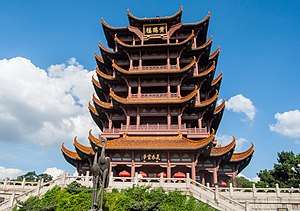
.jpg)
_from_699pic.jpg)
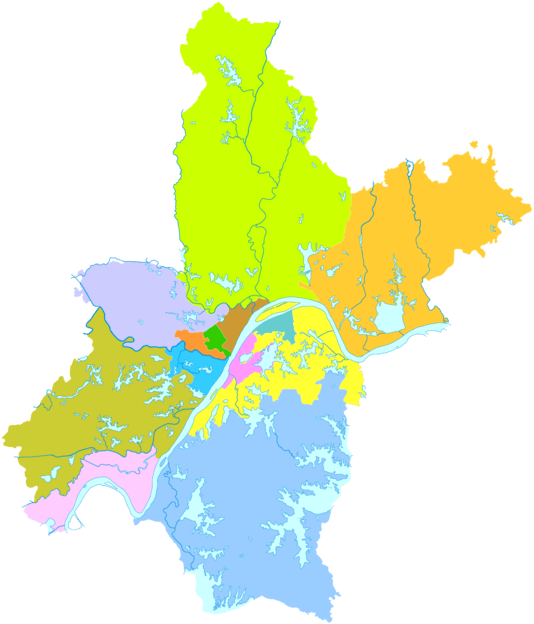


.svg.png)